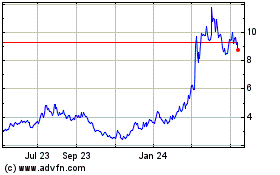false 0001813814 0001813814 2024-03-07 2024-03-07
UNITED STATES
SECURITIES AND EXCHANGE COMMISSION
WASHINGTON, D.C. 20549
FORM 8-K
CURRENT REPORT
Pursuant to Section 13 or 15(d)
of the Securities Exchange Act of 1934
Date of Report (Date of earliest event reported): March 7, 2024
Mind Medicine (MindMed) Inc.
(Exact Name of Registrant as Specified in Its Charter)
|
|
|
|
|
| British Columbia, Canada |
|
001-40360 |
|
98-1582538 |
(State or Other Jurisdiction
of Incorporation) |
|
(Commission File Number) |
|
(IRS Employer
Identification No.) |
|
|
|
One World Trade Center, Suite 8500 New York, New York |
|
10007 |
| (Address of Principal Executive Offices) |
|
(Zip Code) |
Registrant’s telephone number, including area code: (212) 220-6633
Not Applicable
(Former Name or Former Address, if Changed Since Last Report)
Securities registered pursuant to Section 12(b) of the Act:
|
|
|
|
|
Title of each class |
|
Trading symbol(s) |
|
Name of each exchange on which registered |
| Common Shares, no par value per share |
|
MNMD |
|
The Nasdaq Stock Market LLC |
Check the appropriate box below if the Form 8-K filing is intended to simultaneously satisfy the filing obligation of the registrant under any of the following provisions:
| ☐ |
Written communications pursuant to Rule 425 under the Securities Act (17 CFR 230.425) |
| ☐ |
Soliciting material pursuant to Rule 14a-12 under the Exchange Act (17 CFR 240.14a-12) |
| ☐ |
Pre-commencement communications pursuant to Rule 14d-2(b) under the Exchange Act (17 CFR 240.14d-2(b)) |
| ☐ |
Pre-commencement communications pursuant to Rule 13e-4(c) under the Exchange Act (17 CFR 240.13e-4(c)) |
Indicate by check mark whether the registrant is an emerging growth company as defined in Rule 405 of the Securities Act of 1933 (§230.405 of this chapter) or Rule 12b-2 of the Securities Exchange Act of 1934 (§240.12b-2 of this chapter).
Emerging growth company ☒
If an emerging growth company, indicate by check mark if the registrant has elected not to use the extended transition period for complying with any new or revised financial accounting standards provided pursuant to Section 13(a) of the Exchange Act. ☐
Item 7.01. Regulation FD Disclosure.
As previously announced, Mind Medicine (MindMed) Inc. (the “Company”) will host a conference call and webcast to discuss the results of the Company’s Phase 2b trial of MM120 in Generalized Anxiety Disorder at 8:00 a.m. ET on March 7, 2024. A copy of the presentation to be used by the Company during the conference call is furnished as Exhibit 99.1 to this Current Report on Form 8-K.
In accordance with General Instruction B.2. of Form 8-K, the information in this Item 7.01 and Exhibit 99.1 hereto shall not be deemed “filed” for purposes of Section 18 of the Securities Exchange Act of 1934, as amended (the “Exchange Act”), or otherwise subject to the liability of that section, nor shall it be deemed incorporated by reference in any of the Company’s filings under the Securities Act of 1933, as amended, or the Exchange Act, whether made before or after the date hereof, regardless of any incorporation language in such a filing, except as expressly set forth by specific reference in such a filing.
Item 9.01 Financial Statements and Exhibits.
(d) Exhibits.
SIGNATURES
Pursuant to the requirements of the Securities Exchange Act of 1934, the registrant has duly caused this report to be signed on its behalf by the undersigned hereunto duly authorized.
|
|
|
|
|
|
|
| Date: March 7, 2024 |
|
|
|
Mind Medicine (MindMed) Inc. |
|
|
|
|
|
|
|
|
By: |
|
/s/ Robert Barrow |
|
|
|
|
Name: |
|
Robert Barrow |
|
|
|
|
Title: |
|
Chief Executive Officer |

Exhibit 99.1 MM120 for Generalized Anxiety Disorder (GAD) Phase 2b Full
Topline Data ODT PK Bridging Study Breakthrough Therapy Designation March 2024
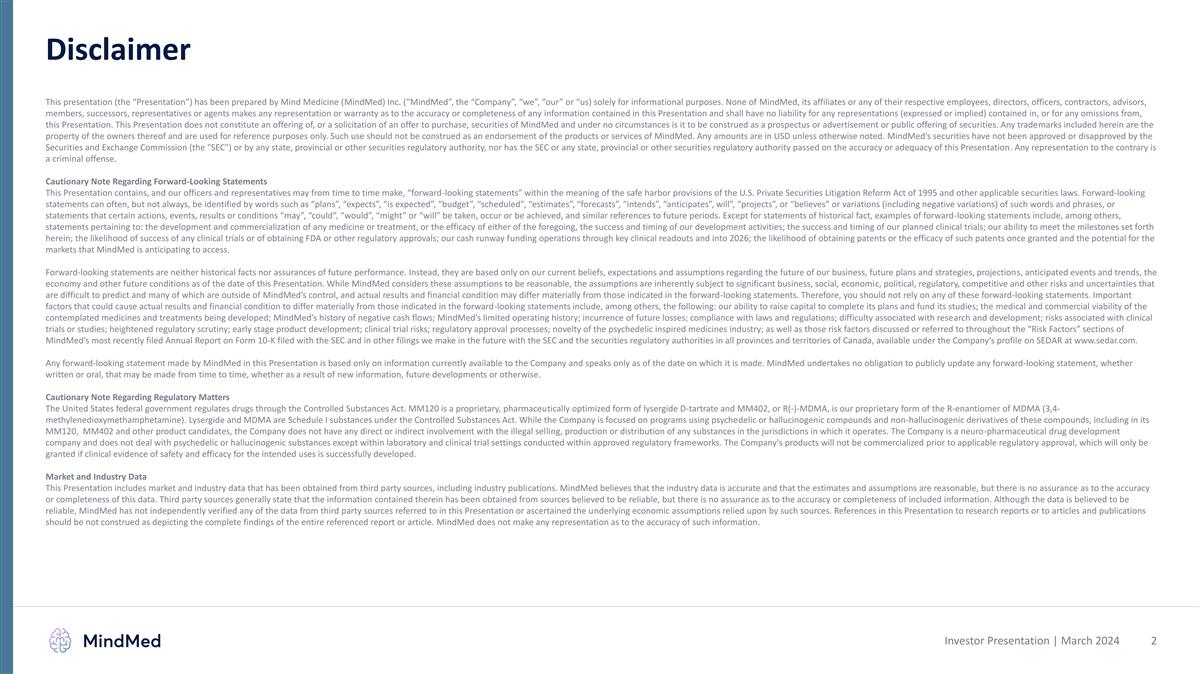
Disclaimer This presentation (the “Presentation”) has been
prepared by Mind Medicine (MindMed) Inc. (“MindMed”, the “Company”, “we”, “our” or “us) solely for informational purposes. None of MindMed, its affiliates or any of their respective employees,
directors, officers, contractors, advisors, members, successors, representatives or agents makes any representation or warranty as to the accuracy or completeness of any information contained in this Presentation and shall have no liability for any
representations (expressed or implied) contained in, or for any omissions from, this Presentation. This Presentation does not constitute an offering of, or a solicitation of an offer to purchase, securities of MindMed and under no circumstances is
it to be construed as a prospectus or advertisement or public offering of securities. Any trademarks included herein are the property of the owners thereof and are used for reference purposes only. Such use should not be construed as an endorsement
of the products or services of MindMed. Any amounts are in USD unless otherwise noted. MindMed’s securities have not been approved or disapproved by the Securities and Exchange Commission (the SEC ) or by any state, provincial or other
securities regulatory authority, nor has the SEC or any state, provincial or other securities regulatory authority passed on the accuracy or adequacy of this Presentation. Any representation to the contrary is a criminal offense. Cautionary Note
Regarding Forward-Looking Statements This Presentation contains, and our officers and representatives may from time to time make, “forward-looking statements” within the meaning of the safe harbor provisions of the U.S. Private
Securities Litigation Reform Act of 1995 and other applicable securities laws. Forward-looking statements can often, but not always, be identified by words such as “plans”, “expects”, “is expected”,
“budget”, “scheduled”, “estimates”, “forecasts”, “intends”, “anticipates”, will”, “projects”, or “believes” or variations (including negative
variations) of such words and phrases, or statements that certain actions, events, results or conditions “may”, “could”, “would”, “might” or “will” be taken, occur or be achieved, and
similar references to future periods. Except for statements of historical fact, examples of forward-looking statements include, among others, statements pertaining to: the development and commercialization of any medicine or treatment, or the
efficacy of either of the foregoing, the success and timing of our development activities; the success and timing of our planned clinical trials; our ability to meet the milestones set forth herein; the likelihood of success of any clinical trials
or of obtaining FDA or other regulatory approvals; our cash runway funding operations through key clinical readouts and into 2026; the likelihood of obtaining patents or the efficacy of such patents once granted and the potential for the markets
that MindMed is anticipating to access. Forward-looking statements are neither historical facts nor assurances of future performance. Instead, they are based only on our current beliefs, expectations and assumptions regarding the future of our
business, future plans and strategies, projections, anticipated events and trends, the economy and other future conditions as of the date of this Presentation. While MindMed considers these assumptions to be reasonable, the assumptions are
inherently subject to significant business, social, economic, political, regulatory, competitive and other risks and uncertainties that are difficult to predict and many of which are outside of MindMed’s control, and actual results and
financial condition may differ materially from those indicated in the forward-looking statements. Therefore, you should not rely on any of these forward-looking statements. Important factors that could cause actual results and financial condition to
differ materially from those indicated in the forward-looking statements include, among others, the following: our ability to raise capital to complete its plans and fund its studies; the medical and commercial viability of the contemplated
medicines and treatments being developed; MindMed’s history of negative cash flows; MindMed’s limited operating history; incurrence of future losses; compliance with laws and regulations; difficulty associated with research and
development; risks associated with clinical trials or studies; heightened regulatory scrutiny; early stage product development; clinical trial risks; regulatory approval processes; novelty of the psychedelic inspired medicines industry; as well as
those risk factors discussed or referred to throughout the “Risk Factors” sections of MindMed’s most recently filed Annual Report on Form 10-K filed with the SEC and in other filings we make in the future with the SEC and the
securities regulatory authorities in all provinces and territories of Canada, available under the Company’s profile on SEDAR at www.sedar.com. Any forward-looking statement made by MindMed in this Presentation is based only on information
currently available to the Company and speaks only as of the date on which it is made. MindMed undertakes no obligation to publicly update any forward-looking statement, whether written or oral, that may be made from time to time, whether as a
result of new information, future developments or otherwise. Cautionary Note Regarding Regulatory Matters The United States federal government regulates drugs through the Controlled Substances Act. MM120 is a proprietary, pharmaceutically optimized
form of lysergide D-tartrate and MM402, or R(-)-MDMA, is our proprietary form of the R-enantiomer of MDMA (3,4- methylenedioxymethamphetamine). Lysergide and MDMA are Schedule I substances under the Controlled Substances Act. While the Company is
focused on programs using psychedelic or hallucinogenic compounds and non-hallucinogenic derivatives of these compounds, including in its MM120, MM402 and other product candidates, the Company does not have any direct or indirect involvement with
the illegal selling, production or distribution of any substances in the jurisdictions in which it operates. The Company is a neuro-pharmaceutical drug development company and does not deal with psychedelic or hallucinogenic substances except within
laboratory and clinical trial settings conducted within approved regulatory frameworks. The Company's products will not be commercialized prior to applicable regulatory approval, which will only be granted if clinical evidence of safety and efficacy
for the intended uses is successfully developed. Market and Industry Data This Presentation includes market and industry data that has been obtained from third party sources, including industry publications. MindMed believes that the industry data
is accurate and that the estimates and assumptions are reasonable, but there is no assurance as to the accuracy or completeness of this data. Third party sources generally state that the information contained therein has been obtained from sources
believed to be reliable, but there is no assurance as to the accuracy or completeness of included information. Although the data is believed to be reliable, MindMed has not independently verified any of the data from third party sources referred to
in this Presentation or ascertained the underlying economic assumptions relied upon by such sources. References in this Presentation to research reports or to articles and publications should be not construed as depicting the complete findings of
the entire referenced report or article. MindMed does not make any representation as to the accuracy of such information. Investor Presentation | March 2024 2

Today’s Agenda Speaker Topic Rob Barrow Introductory Remarks Chief
Executive Officer, MindMed Rakesh Jain, MD, MPH KOL Perspective on Unmet Need in Clinical Professor of Psychiatry and Behavioral Sciences, Texas Tech University Generalized Anxiety Disorder (GAD) & School of Medicine – Permian Basin Phase
2b Trial Results Daniel R Karlin, MD, MA Summary of Full Topline Results from Phase 2b Chief Medical Officer, MindMed Trial of MM120 in GAD Francois Lilienthal, MD, MBA Commercial Opportunity Chief Commercial Officer, MindMed Rob Barrow Summary
Comments for MM120 Development Plan Chief Executive Officer, MindMed Closing Remarks and Questions & Answers (Q&A) All Presenters Investor Presentation | March 2024 3

Introductory Remarks Robert Barrow Chief Executive Officer

We Aim To Be A Global Leader In Brain Health Pipeline Management
Diversified pipeline of clinical Expertise in drug development programs targeting and commercialization significant unmet medical needs Research Expected Runway Leveraging decades of preclinical and clinical Expected cash runway through key research
with promising results in Phase 2b clinical readouts and into 2026* Market Protection Strategies IP and R&D strategies intended to maximize market exclusivity and protection *The company’s cash and cash equivalents of $99.7 million as of
December 31, 2023 and committed credit facility are expected to fund operations into 2026. Investor Presentation | March 2024 5
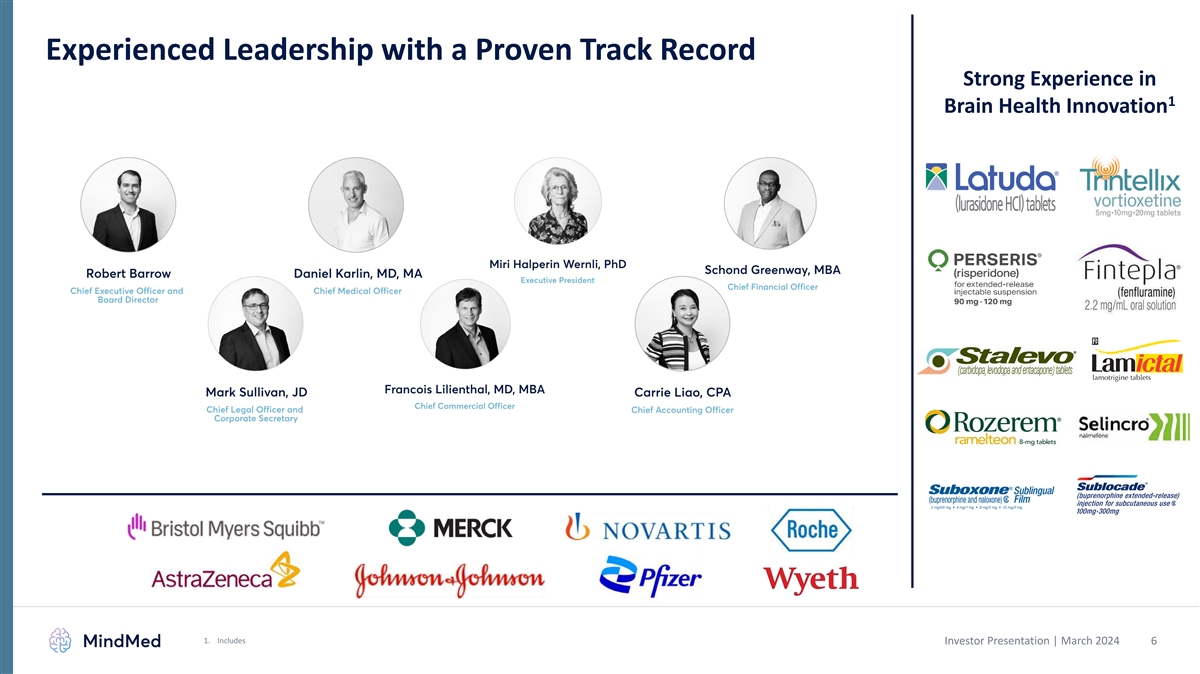
Experienced Leadership with a Proven Track Record Strong Experience in 1
Brain Health Innovation 1. Includes Investor Presentation | March 2024 6

MM120 Has the Potential to Address a Large Unmet Need in GAD Opportunity
in Generalized Anxiety Disorder (GAD) 1 • GAD is the 2nd most common mental disorder among adults , yet there Potential Best-in-Class are limited treatment options Therapy with Novel MOA • Symptoms may be debilitating and treatment
inefficacy leads to incomplete remission and intolerable side effects. 1 Large Market 6.5 million do not respond to 13 million ~20 million US adults with GAD 3 1 2 first-line treatment receive treatment Opportunity 77% moderate to severe 1
SSRI/SNRIs : 50% failure rate with often undesirable side effects Benzodiazepines: addiction, tolerance risk; generally used in short-term Significant Need 4 for New Treatments Buspirone : poor efficacy Antipsychotics: short- and long-term risks;
poorly tolerated 1. Mental and Substance Use Disorders Prevalence Study (MDPSU): Findings Report 2023. 2. Kessler RC, Chiu WT, Demler O et al. Prevalence, Severity, and Comorbidity of 12-month DSM-IV Disorders in the National Comorbidity
Survey-Replication. 2005 Arch Gen Psychiatry; 62(6): 617-627. Investor Presentation | March 2024 7 3. Ansara, Management of Treatment-Resistant Generalized Anxiety Disorder, Ment Health Clin 2020 Nov; 10(6) 326-334) United States Census Bureau,
company calculations. 4. Garakani A, et al., (2020) Pharmacotherapy of Anxiety Disorders: Current and Emerging Treatment Options. Front. Psychiatry 11:595584. doi: 10.3389/fpsyt.2020.595584

MindMed Research & Development Pipeline Product Candidate Indication
Preclinical Phase 1 Phase 2 Phase 3 Registration Psychiatry Programs Generalized Anxiety MM120 1 Disorder (GAD) (Lysergide D-tartrate) Additional Psychiatric 2 Indication MM402 Autism Spectrum 1 Disorder (ASD) (R(-)-MDMA) Early Research &
Collaborations IITs 1 Various (UHB collaboration) Early Research Various (Mindshift collaboration) 1. Full trial details and clinicaltrials.gov links available at mindmed.co/clinical-digital-trials/ 2. Study in exploration and/or planning stage.
Investor Presentation | March 2024 8 LSD: lysergide; MDMA: 3,4-methylenedioxymethamphetamine. IIT: Investigator Initiated Trial (results are not anticipated to be used in our applications for regulatory approval); UHB: University Hospital
Basel
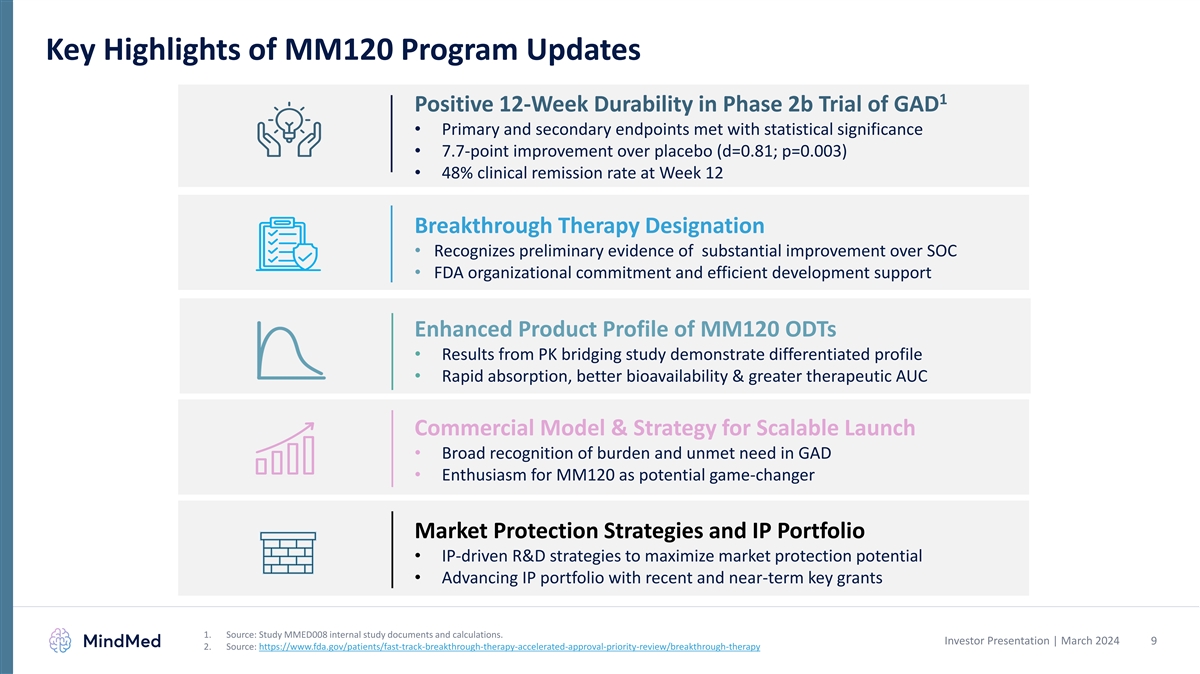
Key Highlights of MM120 Program Updates 1 Positive 12-Week Durability in
Phase 2b Trial of GAD • Primary and secondary endpoints met with statistical significance • 7.7-point improvement over placebo (d=0.81; p=0.003) • 48% clinical remission rate at Week 12 Breakthrough Therapy Designation •
Recognizes preliminary evidence of substantial improvement over SOC • FDA organizational commitment and efficient development support Enhanced Product Profile of MM120 ODTs • Results from PK bridging study demonstrate differentiated
profile • Rapid absorption, better bioavailability & greater therapeutic AUC Commercial Model & Strategy for Scalable Launch • Broad recognition of burden and unmet need in GAD • Enthusiasm for MM120 as potential
game-changer Market Protection Strategies and IP Portfolio • IP-driven R&D strategies to maximize market protection potential • Advancing IP portfolio with recent and near-term key grants 1. Source: Study MMED008 internal study
documents and calculations. Investor Presentation | March 2024 9 2. Source: https://www.fda.gov/patients/fast-track-breakthrough-therapy-accelerated-approval-priority-review/breakthrough-therapy

Results for MM120 in GAD Delivered on Target Product Profile after
Single Dose 1,2 with Significant Improvement in All Endpoints Fast Acting 1.8-point reduction in CGI-S within 24 hours (p<0.0001) 21.9-point improvement in HAM-A at Week 12 (p=0.003) represents Durable Activity further improvement from Week 4 3
Response / Remission 48% of participants in remission at Week 12 Favorable tolerability profile with most AEs limited to dosing Limited Side Effect Burden day Scalability, Access & Value Results achieved with no additional therapy 1. Source:
Study MMED008 internal study documents and calculations. 100 µg dose group. 2. Represents all analyzed secondary endpoints in week 12 topline analysis, including HAM-A, CGI-S and MADRS. Investor Presentation | March 2024 10 3. p-values not
calculated for remission rates between groups. CGI-S: Clinical Global Impressions – Severity; HAM-A: Hamilton Anxiety Scale.

12-Week Durability Observed with Effect Size Over Double the Standard
of 1,3 Care Key Highlights of Phase 2b 12 Comparative Effect Sizes in GAD Week Results • Maximum observed effect size of 0.81 2 MM120 100 µg 0.81 is more than double the standard of 2,3 care 4 Benzodiazepines 0.38 • Rapid and
durable clinical response 3 observed after single administration 4 SSRIs 0.36 • Clinical activity observed with no psychotherapeutic intervention 4 Buspirone 0.17 beyond study drug 0 0.2 0.4 0.6 0.8 1. Source: Study MMED008 internal study
documents and calculations. 2. HAM-A scores based on ANCOVA LS Mean. in Study MMED008. Effect size based on post hoc calculation using LS Mean change between group and pooled standard deviation of week 12 HAM-A scores between groups. Investor
Presentation | March 2024 11 3. Based on 100 µg dose group. 4. Source: RB Hidalgo, J Psychopharmacol. 2007 Nov;21(8):864-72.

FDA Has Designated MM120 a Breakthrough Therapy for GAD MM120 Granted
Breakthrough Benefits of Breakthrough Therapy 1 Therapy Designation Designation • • FDA organizational commitment Recognizes GAD as a serious condition involving senior managers • Phase 2b results demonstrate • Intensive
guidance on an efficient drug preliminary evidence that MM120 for GAD may have a substantial development program 2 improvement over available therapy • Eligibility for Accelerated Approval and 3 Priority Review 4 • Rolling Review of NDA
1. Additional details available at FDA website: https://www.fda.gov/patients/fast-track-breakthrough-therapy-accelerated-approval-priority-review/breakthrough-therapy 2. Based on clinically significant endpoint(s) 3. If relevant criteria are met
Investor Presentation | March 2024 12 4. Means that a drug company can submit completed sections of its New Drug Application (NDA) for review by FDA, rather than waiting until every section of the NDA is completed before the entire application can
be reviewed. NDA review usually does not begin until the drug company has submitted the entire application to the FDA.

PK Bridging Study Demonstrates Enhanced Product Profile for MM120 ODTs
1 Comparative PK Profile 2.5 MM120 Capsule Differentiated Performance of MM120 ODTs MM120 ODT 2 2 50% faster onset of action 1.5 3 17% improved bioavailability 1 4 0.5 23% increase in AUC at target conc. AUC 0 5 0 2 4 6 8 10 12 14 16 18 20 22 24
Reduced GI side effects Time (hours) 1. Company analysis of pharmacokinetic data from Study MM120-101. PK analysis based on n=24 subjects that completed both dosing sessions. 2. Based on time to reach target concentration of >1 ng/mL. 3. Based on
comparison of geometric mean ratio of total area under the curve. Investor Presentation | March 2024 13 4. Based on ratio of mean AUC . Target concentrations defined as level above which perceptual effects are present. >1ng/mL 5. Based on a
comparison between Phase 2b study of MM120 capsules in GAD versus PK bridging study of MM120 ODTs AUC: area under the curve; GI: gastrointestinal; ODT: orally dissolving tablet; PK: pharmacokinetics MM120 Concentration (ng/mL)
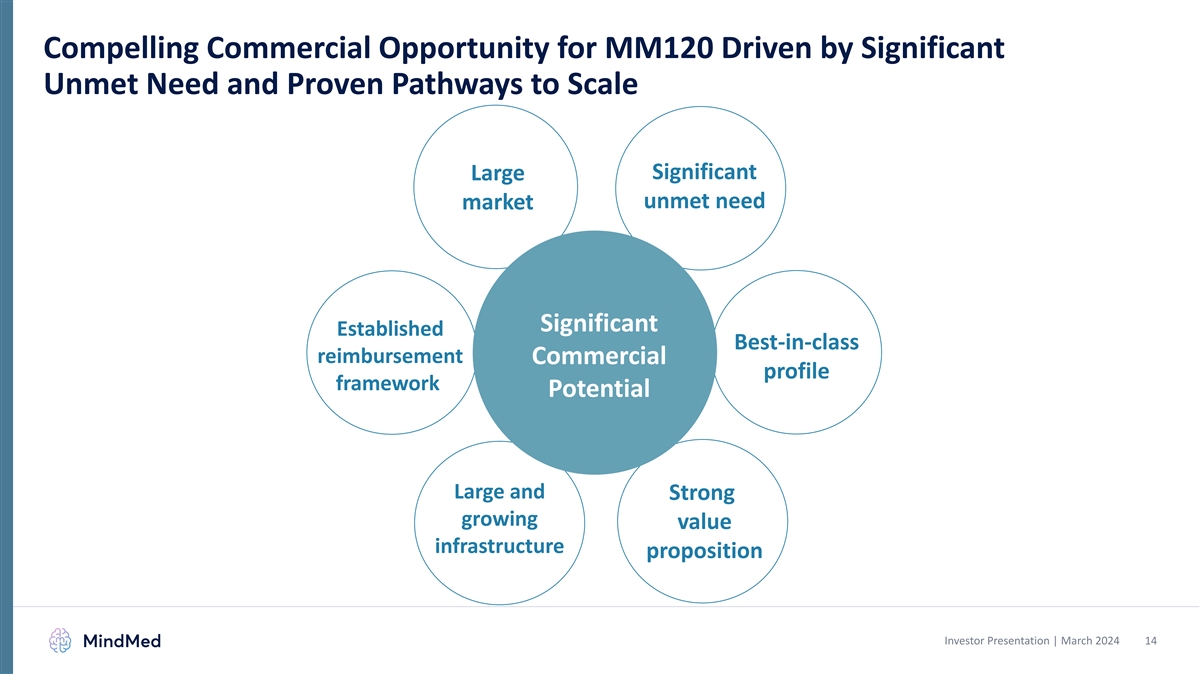
Compelling Commercial Opportunity for MM120 Driven by Significant Unmet
Need and Proven Pathways to Scale Significant Large unmet need market Significant Established Best-in-class reimbursement Commercial profile framework Potential Large and Strong growing value infrastructure proposition Investor Presentation | March
2024 14

KOL Perspective on Impact and Unmet Need in GAD Rakesh Jain, MD, MPH
Clinical Professor of Psychiatry and Behavioral Sciences, Texas Tech University School of Medicine – Permian Basin

Perspective on Impact and Unmet Need in GAD • GAD has a negative
impact on many aspects of patients’ lives which Increases with severity • GAD is chronic in nature, worsens with time and often precedes additional psychiatric disorders 1 • Anxiety returning to focus as a major driver of brain
health disorders • Patients are underserved by current medications 1 • GAD patients express a desire for new treatment options 2 • GAD has seen limited innovation in decades - Cymbalta last drug approved for GAD (February 2007)
• Current treatments often aren’t effective or tolerated and can require numerous cycles of switching and dosage adjustments 3 • Decades of LSD Clinical Research in Psychiatric Disorders Supports its Unique Potential 1.
“Anxiety in Children and Adolescents: Screening” (2022). The United States Preventative Services Task Force; ”Anxiety Disorders in Adults: Screening” Draft Recommendation (2022). The United States Preventative Services Task
Force. 2. Based on patient research conducted by MindMed in 2023. Investor Presentation | March 2024 16 3. https://investor.lilly.com/news-releases/news-release-details/fda-approves-cymbaltar-treatment-generalized-anxiety-disorder#. 4. Rucker 2016,
Gasset 2014, Holze,Gasser et al 2022, UHB presentation April 2023.

Overview of Generalized Anxiety Disorder Generalized Anxiety Disorder
(GAD) Epidemiology of Anxiety •• Prevalent disorder characterized by persistent 10% prevalence has tripled in past two decades and excessive worry about various aspects of life • More prevalent in women than in men (~2:1) •
Individuals with GAD often find it challenging to • control their anxiety, leading to significant distress Onset typically in adolescence or early adulthood and impairment in daily functioning • Common comorbid psychiatric conditions,
such as • Typically manifests with restlessness, fatigue, major depressive disorder and other anxiety disorders difficulty concentrating, irritability, muscle tension, and sleep disturbances nd • 2 most common mental disorder among
adults 18 to 65 years old Investor Presentation | March 2024 17

GAD Has Negative Impact on Many Aspects of Patients’ Lives which
Increases with Severity Mean Health Utilities Index by GAD Severity GAD Impact on Patients 40 < Psychological well-being 35 30 25 Physical functioning 20 15 10 Disease specific quality of life 5 0 Asymtomatic Mild Moderate Severe (HAM-A <9)
(HAM-A 10-15) (HAM-A 16-24) (HAM-A >25) Disability in everyday life Revicki et al. (2008) Investor Presentation | March 2024 18

GAD is Chronic in Nature, Worsens with Time and Often Precedes
Additional 1 Psychiatric Disorders Substance use Panic Disorder MDD TIME SINCE ONSET 1. The Critical Relationship Between Anxiety and Depression - 1 May 2020https://doi.org/10.1176/appi.ajp.2020.20030305 Investor Presentation | March 2024 19
SEVERITY & COMORBIDITIES

As the Mainstream Focus on Anxiety Returns, Patients Continue to be
Underserved by Current Medications Population Recommendation Grade Children and adolescents aged 8 to The USPSTF recommends screening for anxiety in children B 1 18 years and adolescents aged 8 to 18 years. The USPSTF recommends screening for
anxiety in adults, Adults aged 64 years or younger B 2 including pregnant and postpartum persons. Grade “B” recommendations from the USPSTF indicate: “The USPSTF recommends the service. There is a high certainty that the net
benefit is moderate, or there is moderate certainty that the net benefit is moderate to substantial.” Generally front line, 50% failure rate, 3 sexual side effects can be durable 1. “Anxiety in Children and Adolescents: Screening”
(2022). The United States Preventative Services Task Force. 2. ”Anxiety Disorders in Adults: Screening” Draft Recommendation (2022). The United States Preventative Services Task Force. 1. “Anxiety in Children and Adolescents:
Screening” (2022). The United States Preventative Services Task Force Investor Presentation | March 2024 20 2. ”Anxiety Disorders in Adults: Screening” Draft Recommendation (2022). The United States Preventative Services Task
Force. 3. Ansara, Ment Health Clin. 2020 Nov; 10(6):326-334). Fda.gov/. United States Census Bureau, company calculations.

GAD Patients Express a Desire for New Treatment Options 1 Limitations
of Current SOC Quotes from GAD Patients They told me the medication would take 6 weeks to Slow Acting work. I didn’t want to feel like this for another 6 weeks If I’m inconsistent with medication, or run out for a day, Non-Durable
Activity it makes me feel terrible being off of it for one day. My goal is remission, I don’t want to be connected to taking Limited Response the pills to function. I didn’t like the sexual side effects and feeling like a Side Effect
Burden zombie from the medication. 1. Based on patient research conducted by MindMed in 2023. Investor Presentation | March 2024 21 GAD: Generalized Anxiety Disorder; SOC: standard of care

Current Treatments Often Aren’t Effective or Tolerated and Can
Require Numerous Cycles of Switching and Dosage Adjustments Primary Care Follow-up Visits, Oral daily Diagnosis + Rx Switching & Dose Patient treatment Adjustments Investor Presentation | March 2024 22 Source:. Company market
research.

Decades of LSD Clinical Research in Psychiatric Disorders Supports its
Unique Potential Investor Presentation | March 2024 23

MM120 LSD-D-tartrate for Generalized Anxiety Disorder (GAD) Summary of
Full Topline Results from Phase 2b Trial Daniel R Karlin, MD, MA Chief Medical Officer

Positive 12-Week Topline Results from Phase 2b Study in GAD: Strong
Durability 1 of Effect after Single Dose of MM120 2 • Met the primary and all secondary endpoints with statistical significance • MCP-Mod analysis results support dose-response relationship for MM120 in GAD 3,4 • Large observed
effect size of d=0.81 at 12 weeks is more than double the standard of care o Durability of at least 3 months after a single dose of MM120 observed • Statistically and clinically significant 21.9-point improvement in HAM-A score at week 12
(p=0.0025) represents 3 further improvement from four-week topline data o Rapid and durable clinical activity with continued improvement at week 12 5 o 48% clinical remission rate through 12-week observation period 2 o Clinically and statistically
significant improvements on all analyzed secondary endpoints at week 12 • MM120 was well-tolerated with no related serious adverse events o Mostly transient, mild-to-moderate adverse events consistent with drug class and prior studies 6 o No
drug-related serious adverse event (SAE) and no suicide-related safety signal • Supports long-term durability of single administration MM120 and we believe further supports advancement of 100 µg MM120 into Phase 3 development for GAD 1.
Source: Study MMED008 internal study documents and calculations. Individual group results reported on 100 µg dose group vs. placebo. 2. Represents all analyzed secondary endpoints in week 12 topline analysis, including HAM-A, CGI-S and MADRS.
3. Based on 100 µg dose group; HAM-A scores based on ANCOVA LS Mean. Effect size based on post hoc calculation by study statistician using LS Mean change between group and pooled standard deviation of ending HAM-A scores across groups. 4.
Examination of baseline group assignment for all of the studies (20 studies utilizing the HAM-A (Hamilton Anxiety Scale) and 1 study using the PARS (Pediatric Anxiety Scale) for the primary outcome measurement. Source: RB Hidalgo, J Investor
Presentation | March 2024 25 Psychopharmacol. 2007 Nov;21(8):864-72. 5. Remission defined as HAM-A score of ≤7. 6. Suicidality assessment based on reported adverse events.

Phase 2b Trial of MM120 Utilized Standard GAD Design and Endpoints and
was 1 Aligned with FDA Draft Guidance for Drug Class • Standard GAD study design with endpoints that have supported registration for approved drugs • Randomized, double-blind, placebo-controlled, 12-week trial o Single administration of
MM120 or placebo o No psychotherapeutic intervention 2 o Trial design closely aligned with subsequently issued FDA 2023 Draft Guidance o Patients washed out of anxiety pharmacotherapy prior to randomization • Enrolled 198 patients with GAD
• Five-arm dose optimization design with 1:1:1:1:1 randomization • Primary endpoint: change in Hamilton Anxiety Scale (HAM-A) at week 4 o Assessed by central rater blinded to treatment assignment and visit number 1. Source: Study MMED008
internal study documents and calculations. Investor Presentation | March 2024 26 2. FDA 2023 Draft Guidance: Psychedelic Drugs: Considerations for Clinical Investigations.

1 Phase 2b Trial Schematic 198 participants total (actual) Study
MMED008 | MM120 for GAD Week 8 12 -5 to -1 1 2 4 A Phase 2b Dose Optimization Study of a Single Dose of MM120 in Generalized Dose Follow-Up Screening Anxiety Disorder MM120 200 µg KEY ENTRY CRITERIA MM120 100 µg • Men and Women
• Ages 18-74 MM120 50 µg • Diagnosis of GAD MM120 25 µg • HAM-A ≥ 20 Placebo ADDITIONAL ENDPOINTS • MADRS• EQ-5D-5L • CGI-S / I• PSQI Randomize Primary Endpoint Secondary Endpoints •
PGI-S / C• ASEX (HAM-A) (HAM-A) • SDS 1. Source: Study MMED008 internal study documents. μg: microgram; HAM-A: Hamilton Anxiety Rating Scale; MADRS: Montgomery-Asberg Depression Rating Scale; CGI-S: Clinical Global Impressions -
Severity; PGI-S: Patient Global Impression - Investor Presentation | March 2024 27 Severity; SDS: Sheehan Disability Scale; EQ-5D-5L: EuroQol-5 Dimension; PSQI: Pittsburgh Sleep Quality Index; ASEX: Arizona Sexual Experiences Scale

Phase 2b Treatment Paradigm: Standalone Drug Effects with No 1
Psychotherapeutic Intervention • Dosing session monitors (DSMs) in the room provide no psychotherapeutic intervention 2 • Delivery protocol consistent with 2023 FDA Draft Guidance • No changes planned to drug delivery between Phase
2 and Phase 3 Pre-treatment During treatment Post-treatment ✓ Comprehensive informed consent process✓ Continuous monitoring by DSMs✓ Follow-up visits for assessment only Patient ✓ Eligibility evaluation✓ Music, eye
shades, reading, writing Journey in MMED008 ✓ Concludes when discharge criteria met x No “preparation” x No “assisted therapy” x No “integration” Not Part of Patient Journey in x Pre-treatment activities
consisted of a x No psychotherapy and no therapeutic x No ongoing therapeutic engagement as MMED008 comprehensive informed consent process intervention beyond study drug part of clinical trial activities 1. Source: Study MMED008 internal study
documents. Investor Presentation | March 2024 28 2. FDA 2023 Draft Guidance: Psychedelic Drugs: Considerations for Clinical Investigations.
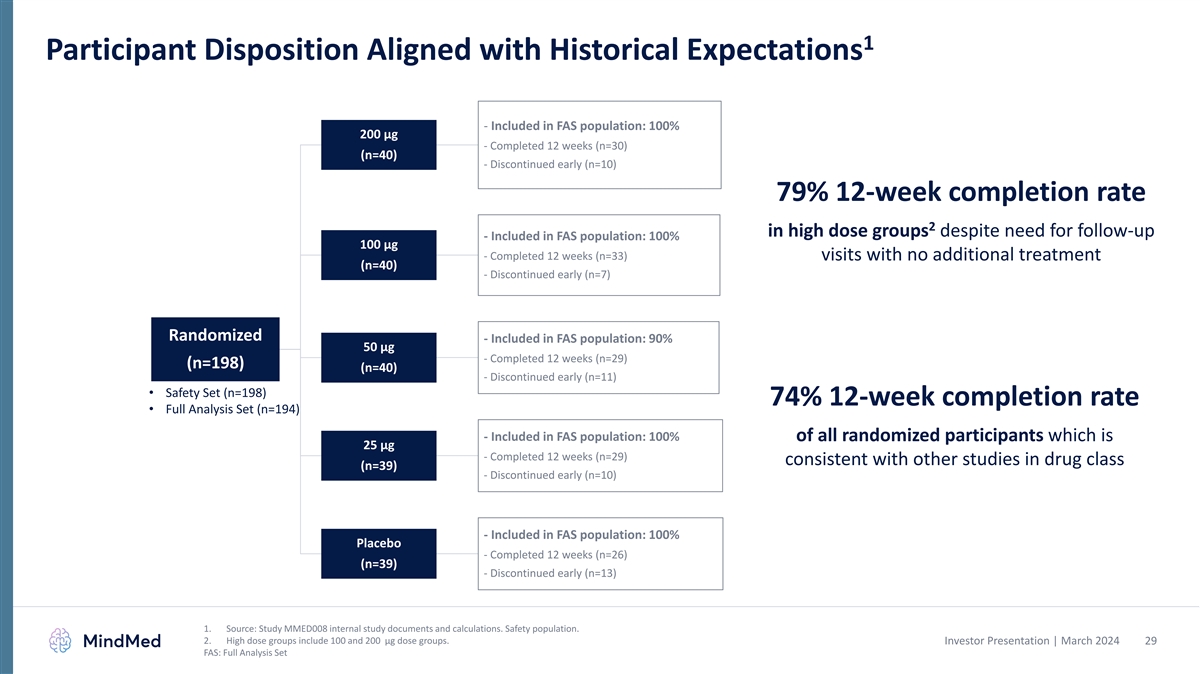
1 Participant Disposition Aligned with Historical Expectations -
Included in FAS population: 100% 200 µg - Completed 12 weeks (n=30) (n=40) - Discontinued early (n=10) 79% 12-week completion rate 2 in high dose groups despite need for follow-up - Included in FAS population: 100% 100 µg - Completed 12
weeks (n=33) visits with no additional treatment (n=40) - Discontinued early (n=7) Randomized - Included in FAS population: 90% 50 µg - Completed 12 weeks (n=29) (n=198) (n=40) - Discontinued early (n=11) • Safety Set (n=198) 74% 12-week
completion rate • Full Analysis Set (n=194) - Included in FAS population: 100% of all randomized participants which is 25 µg - Completed 12 weeks (n=29) consistent with other studies in drug class (n=39) - Discontinued early (n=10) -
Included in FAS population: 100% Placebo - Completed 12 weeks (n=26) (n=39) - Discontinued early (n=13) 1. Source: Study MMED008 internal study documents and calculations. Safety population. 2. High dose groups include 100 and 200 µg dose
groups. Investor Presentation | March 2024 29 FAS: Full Analysis Set

Participant Demographics and Baseline Characteristics Generally
Balanced 1 Across Groups MM120 Placebo Demographic (n=194) 25 µg 50 µg 100 µg 200 µg (n=39) (n=36) (n=40) (n=40) (n=39) Mean age (years) 38.0 45.3 42.7 42.1 38.7 Sex, female (%) 51.3% 55.6% 40.0% 70.0% 66.7% Race (% white) 84.6%
80.6% 90.0% 82.5% 76.9% Baseline HAM-A score 30.2 30.3 29.3 31.0 30.3 Baseline CGI-S score 4.9 4.9 4.8 5.1 4.9 1. Source: Study MMED008 internal study documents and calculations. Full analysis set population. Investor Presentation | March 2024
30

Statistically and Clinically Significant Reductions in HAM-A Score
Continued at 1,2 Week 12 HAM-A Change from Baseline 2 0 Change from Baseline • Week 4: -21.3 points • Week 12: -21.9 points -5 2 Improvement over Placebo -10 • Week 4: -7.6 pts, p=0.0004 • Week 12: -7.7 pts, p=0.003 -15 -20
*** *** ** *** *** * ** -25 ** ** **p<0.05 **p≤0.01 ***p≤0.001 Placebo 25 µg 50 µg 100 µg 200 µg 1. Source: Study MMED008 internal study documents and calculations. Full analysis set population. 2. Based on 100
µg dose group. Investor Presentation | March 2024 31 μg: microgram; HAM-A: Hamilton Anxiety Rating Scale; NOTE: Significance achieved despite study not being powered for these pairwise comparisons. LS Mean Change (SEM) in HAM-A
score
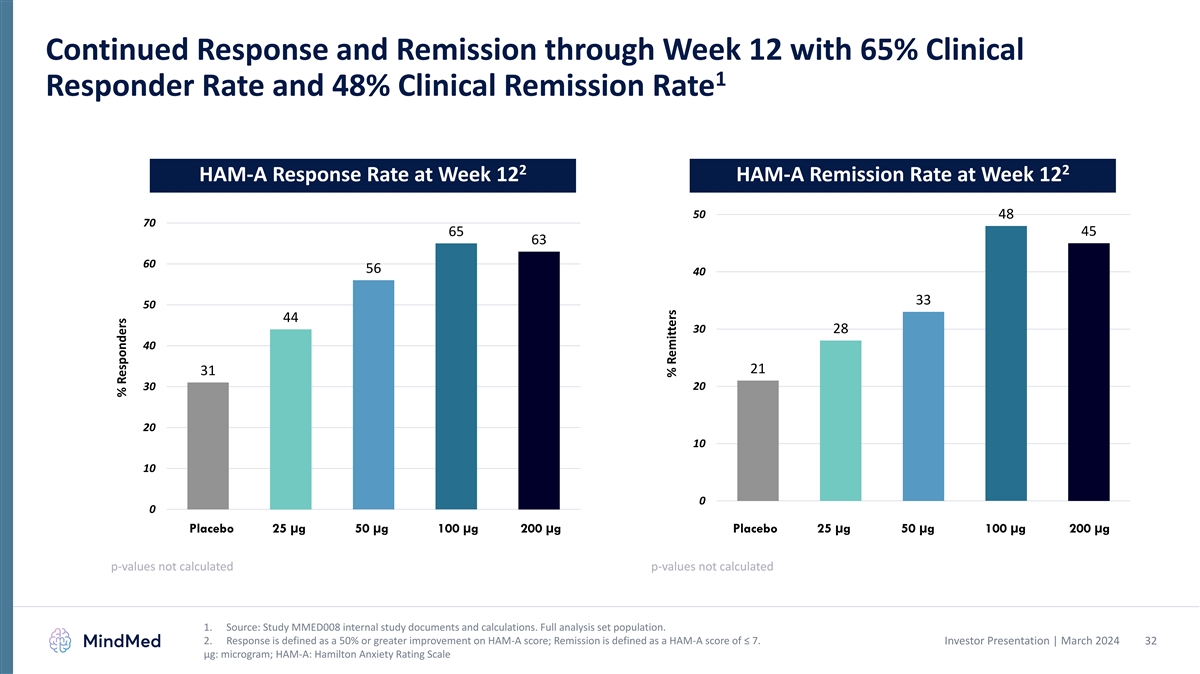
Continued Response and Remission through Week 12 with 65% Clinical 1
Responder Rate and 48% Clinical Remission Rate 2 2 HAM-A Response Rate at Week 12 HAM-A Remission Rate at Week 12 50 48 70 65 45 63 60 56 40 33 50 44 30 28 40 21 31 30 20 20 10 10 0 0 Placebo 25 µg 50 µg 100 µg 200 µg Placebo 25
µg 50 µg 100 µg 200 µg p-values not calculated p-values not calculated 1. Source: Study MMED008 internal study documents and calculations. Full analysis set population. 2. Response is defined as a 50% or greater improvement on
HAM-A score; Remission is defined as a HAM-A score of ≤ 7. Investor Presentation | March 2024 32 μg: microgram; HAM-A: Hamilton Anxiety Rating Scale % Responders % Remitters

Primary & Key Secondary Analysis (MCP-Mod) Support Dose Response 1
Relationship for MM120 in GAD 2 Key Takeaways from MCP-Mod Analysis • Statistically significant dose response relationship with multiple model fits • Supports dose selection of 100 µg for subsequent studies in GAD •
Pre-specified model estimates and observed responses drive dose selection for Phase 3 studies Dose 1. Source: Study MMED008 internal study documents and calculations. Full analysis set population. 2. Source: Novartis. “The MCP-Mod methodology
– A statistical methodology for dose-response. Investor Presentation | March 2024 33 ` Model Means

Rapid and Sustained Improvements in Clinical Global Impressions –
Severity 1 (CGI-S) Starting on Day 2 and Continuing through Week 12 2 CGI-S Improvement in 100 µg Group CGI-S Scores at Week 12 6 – Severely Ill • Statistically and clinically significant improvement by Day 2 and 5 – Markedly
Ill maintained through Week 12 4 – Moderately Ill • Greater than 2-unit improvement in CGI-S score through Week 12 **** 3 – Mildly Ill *** ** • Participants on average only 2 – Borderline Ill borderline-to-mildly ill at
Week 12 1 – Normal, not ill at all Baseline Day 2 Week 4 Week 12 Placebo 100 µg *p<0.05 **p≤0.01 ***p≤0.001 ****p≤0.0001 1. Source: Study MMED008 internal study documents and calculations. Full analysis set
population. 2. Significance achieved despite study not being powered for these pairwise comparisons. Investor Presentation | March 2024 34 μg: microgram; CGI-S: Clinical Global Impressions - Severity
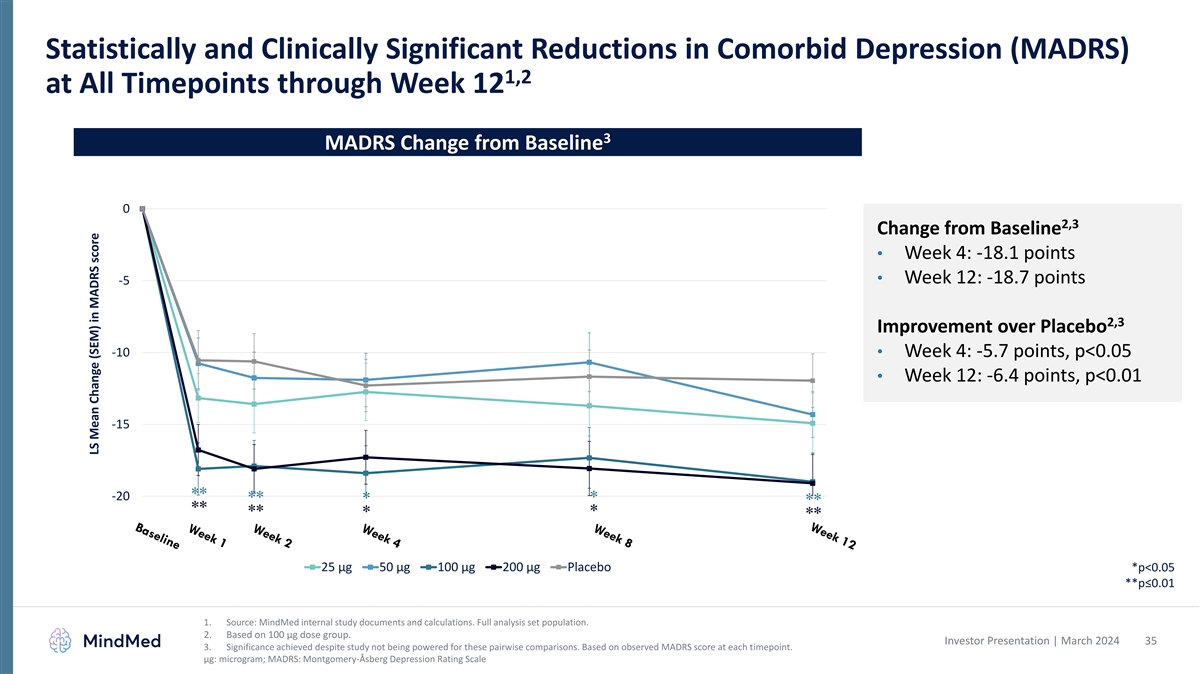
Statistically and Clinically Significant Reductions in Comorbid
Depression (MADRS) 1,2 at All Timepoints through Week 12 3 MADRS Change from Baseline 0 2,3 Change from Baseline • Week 4: -18.1 points • Week 12: -18.7 points -5 2,3 Improvement over Placebo -10 • Week 4: -5.7 points, p<0.05
• Week 12: -6.4 points, p<0.01 -15 ** -20 ** * * ** ** ** * * ** 25 µg 50 µg 100 µg 200 µg Placebo *p<0.05 **p≤0.01 1. Source: MindMed internal study documents and calculations. Full analysis set population. 2.
Based on 100 µg dose group. Investor Presentation | March 2024 35 3. Significance achieved despite study not being powered for these pairwise comparisons. Based on observed MADRS score at each timepoint. μg: microgram; MADRS:
Montgomery-Åsberg Depression Rating Scale LS Mean Change (SEM) in MADRS score

MM120 was Well-tolerated with Mostly Transient, Mild-to-Moderate
Adverse 1 Events Consistent with Drug Class Expectations • Virtually all AEs (99%) were mild-to-moderate in severity Favorable tolerability • Minimal (2.5%) TEAEs led to study withdrawal profile 2 • No drug-related serious adverse
events (SAEs) No SAEs related to • Only SAE was in 50 µg dose group and deemed unrelated study drug • Adverse event profile consistent with historical studies and drug class • No suicidal or self-injurious behavior No suicidal
behavior • ≤ 2 participant per arm reported suicidal ideation during the study 3 or suicidality signal • No indication of increased suicidality or suicide-related risk 1. Source: Study MMED008 internal study documents and
calculations. Safety population. 2. One serious adverse event (SAE) was observed in the 50 µg dose group: panic attack on study day 98 that was deemed not related to treatment. Investor Presentation | March 2024 36 3. Suicidality assessment
based on reported adverse events.

Most Common (≥10%) TEAEs in High-Dose Groups Demonstrate
Favorable 1,2 Tolerability Profile MM120 Preferred Term Placebo (n=39) 25 µg 50 µg 100 µg 200 µg (n=39) (n=40) (n=40) (n=40) Subjects (%) with AE DD AFT DD AFT DD AFT DD AFT DD AFT Illusion 12 (31) 1 (2.6) 18 (45) 1 (2.5) 24 (60)
1 (2.5) 30 (75) – 3 (7.7) – Nausea 3 (7.7) – 11 (28) – 16 (40) 1 (2.5) 24 (60) 2 (5.0) 1 (2.6) 2 (5.1) Headache 4 (10) 2 (5.1) 9 (23) 2 (5.0) 10 (25) 4 (10) 10 (25) 1 (2.5) 8 (21) 1 (2.6) Hallucination, visual 6 (15) 1 (2.6)
9 (23) – 9 (23) – 6 (15) – 1 (2.6) – Euphoric mood 2 (5.1) – 5 (13) – 11 (28) – 6 (15) – 1 (2.6) – Anxiety 1 (2.6) 3 (7.7) 3 (7.5) 3 (7.5) 4 (10) – 5 (13) 1 (2.5) – 2 (5.1) Mydriasis
1 (2.6) – 7 (18) – 8 (20) – 4 (10) – 1 (2.6) – Hyperhidrosis 1 (2.6) – 4 (10) – 9 (23) – 5 (13) – – – Paraesthesia 2 (5.1) – 2 (5.0) – 2 (5.0) – 8 (20) – 2
(5.1) 1 (2.6) Blood pressure increased 3 (7.7) – 5 (13) – 4 (10) – 4 (10) – – – Dizziness 3 (7.7) – 2 (5.0) – 3 (7.5) – 5 (13) – 1 (2.6) – Tremor – – 3 (7.5) – 2
(5.0) 1 (2.5) 8 (20) – – – Thinking abnormal 1 (2.6) – 2 (5.0) – 4 (10) 1 (2.5) 5 (13) – – – Pseudohallucination – – 3 (7.5) – 3 (7.5) – 4 (10) – – – Feeling
abnormal 1 (2.6) – 2 (5.0) – – – – 4 (10) 1 (2.6) 1 (2.6) COVID-19 – 1 (2.6) – 2 (5.0) – 1 (2.5) – 4 (10) – – 1. Source: Study MMED008 internal study documents and calculations.
Safety population. 2. High dose groups include 100 and 200 µg dose groups. Investor Presentation | March 2024 37 AFT: After Dosing Day; DD: Dosing Day; TEAE: Treatment-emergent adverse event.

MM120 LSD-D-tartrate for Generalized Anxiety Disorder (GAD) MM120 ODT
PK Bridging Study Daniel R Karlin, MD, MA Chief Medical Officer
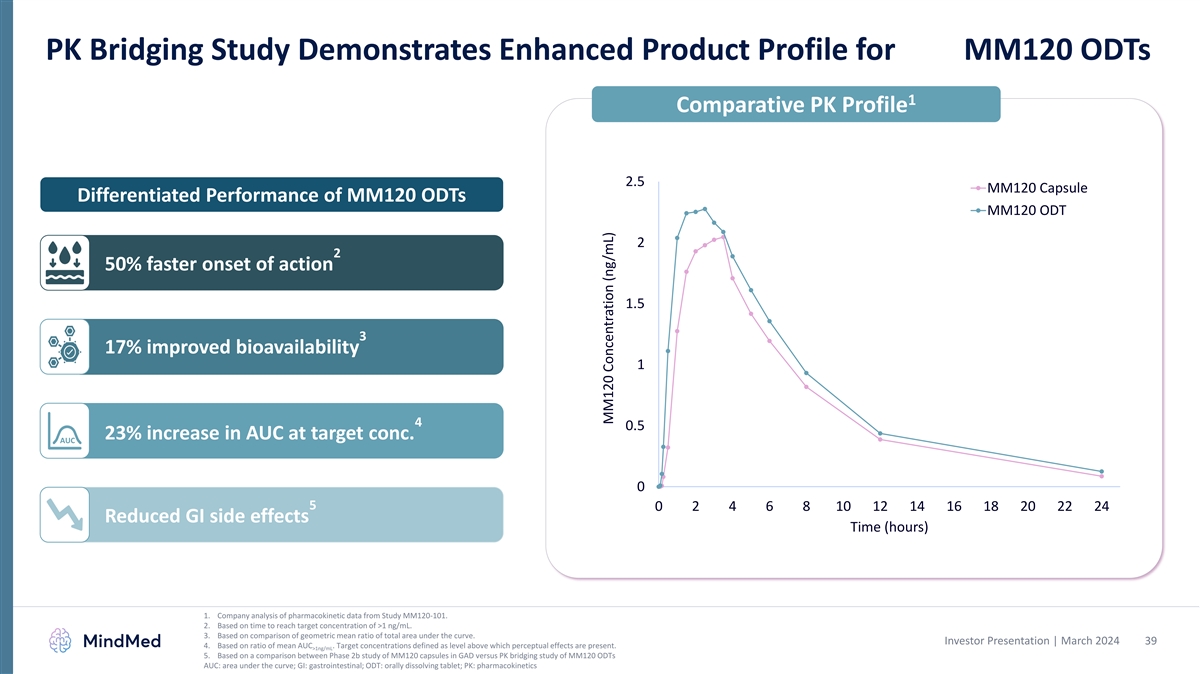
PK Bridging Study Demonstrates Enhanced Product Profile for MM120 ODTs
1 Comparative PK Profile 2.5 MM120 Capsule Differentiated Performance of MM120 ODTs MM120 ODT 2 2 50% faster onset of action 1.5 3 17% improved bioavailability 1 4 0.5 23% increase in AUC at target conc. AUC 0 5 0 2 4 6 8 10 12 14 16 18 20 22 24
Reduced GI side effects Time (hours) 1. Company analysis of pharmacokinetic data from Study MM120-101. 2. Based on time to reach target concentration of >1 ng/mL. 3. Based on comparison of geometric mean ratio of total area under the curve.
Investor Presentation | March 2024 39 4. Based on ratio of mean AUC . Target concentrations defined as level above which perceptual effects are present. >1ng/mL 5. Based on a comparison between Phase 2b study of MM120 capsules in GAD versus PK
bridging study of MM120 ODTs AUC: area under the curve; GI: gastrointestinal; ODT: orally dissolving tablet; PK: pharmacokinetics MM120 Concentration (ng/mL)

1 MM120 ODT PK Bridging Study Schematic Study MM120-101 | ODT-PK
Bridging 29 participants total (actual) A Phase 1, Open-label Study to Compare the Pharmacokinetics of Two Formulations Day -21 to -1 1 2-13 14 15-29 of MM120 in Healthy Volunteers Dose 2 Follow-up Washout Dose 1 Screening MM120 MM120 ENTRY CRITERIA
Zydis ODT Zydis ODT • Men and Women (100 µg) (100 µg) • Ages 18-55 • Healthy volunteers • No prohibited medications MM120 MM120 Capsule Capsule (100 µg) (100 µg) Enrollment 1. Based on internal study
documents for Study MM120-101 Investor Presentation | March 2024 40 ODT: orally dissolving tablet

Comparative PK of MM120 ODT vs Capsule Demonstrates Favorable Profile
of 1 MM120 ODTs 2.5 MM120 Capsule MM120 ODT MM120 1 2 PK Parameter MM120 ODT Capsule 1.5 T (hr) 2.25 2.0 max C (ng/mL) 2.63 2.68 1 max AUC (ng*hr/mL) 15.7 18.7 0-∞ 0.5 AUC (ng*hr/mL) 9.7 12.0 >1ng/mL 0 0 2 4 6 8 10 12 14 16 18 20 22 24 Time
(hours) 1. Company analysis of pharmacokinetic data from Study MM120-101. PK analysis based on n=24 subjects that completed both dosing sessions. Investor Presentation | March 2024 41 AUC: area under the curve; C : maximum achieved concentration;
ODT: orally dissolving tablet; PK: pharmacokinetics; T : time to maximum concentration max max MM120 Concentration (ng/mL)

MM120 ODT Demonstrates Faster Absorption and Shorter Time to Reach
Target Concentrations 1.2 MM120 Capsule 1 Differentiated PK Profile of MM120 ODTs MM120 ODT 1 2 50% faster onset of action 0.8 0.6 3 17% improved bioavailability 0.4 4 0.2 23% increased AUC above target conc. AUC 0 0 10 20 30 Time (minutes) 1.
Company analysis of pharmacokinetic data from Study MM120-101. PK analysis based on n=24 subjects that completed both dosing sessions. 2. Based on time to reach target concentration of >1 ng/mL. 3. Based on comparison of geometric mean ratio of
total area under the curve. Investor Presentation | March 2024 42 4. Based on ratio of mean AUC . Target concentrations defined as level above which perceptual effects are present. >1ng/mL AUC: area under the curve; ODT: orally dissolving tablet;
PK: pharmacokinetics MM120 Concentration (ng/mL)
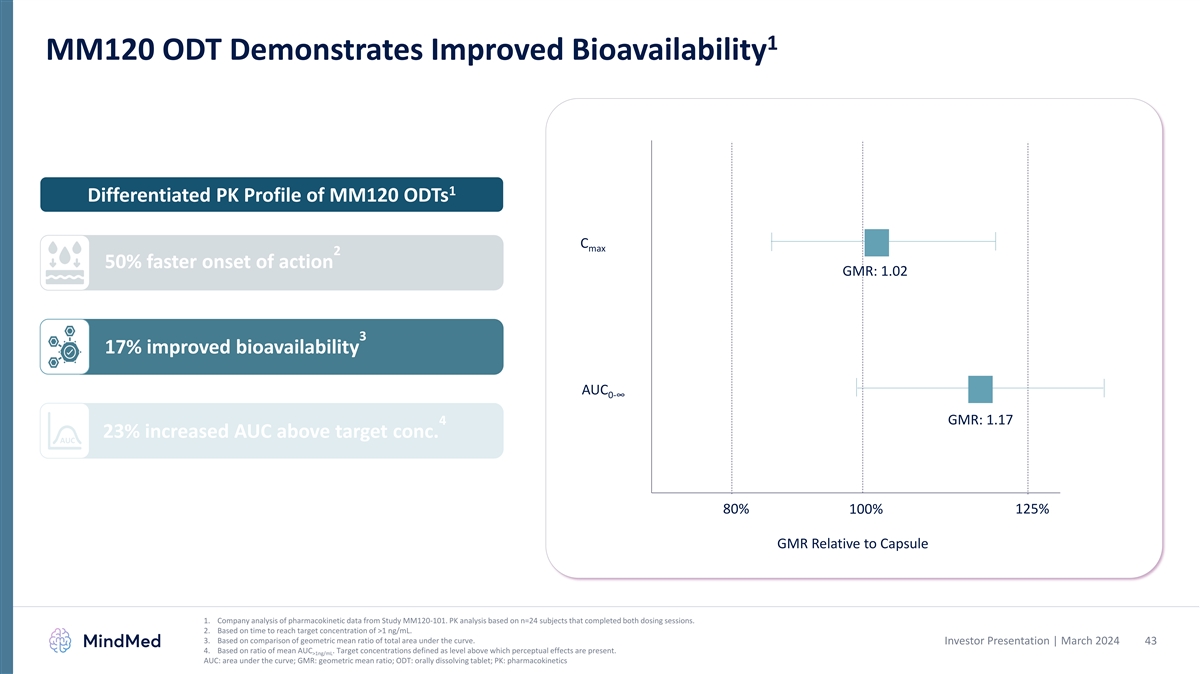
1 MM120 ODT Demonstrates Improved Bioavailability 1 Differentiated PK
Profile of MM120 ODTs C max 2 50% faster onset of action GMR: 1.02 3 17% improved bioavailability AUC 0-∞ GMR: 1.17 4 23% increased AUC above target conc. AUC 80% 100% 125% GMR Relative to Capsule 1. Company analysis of pharmacokinetic data
from Study MM120-101. PK analysis based on n=24 subjects that completed both dosing sessions. 2. Based on time to reach target concentration of >1 ng/mL. 3. Based on comparison of geometric mean ratio of total area under the curve. Investor
Presentation | March 2024 43 4. Based on ratio of mean AUC . Target concentrations defined as level above which perceptual effects are present. >1ng/mL AUC: area under the curve; GMR: geometric mean ratio; ODT: orally dissolving tablet; PK:
pharmacokinetics
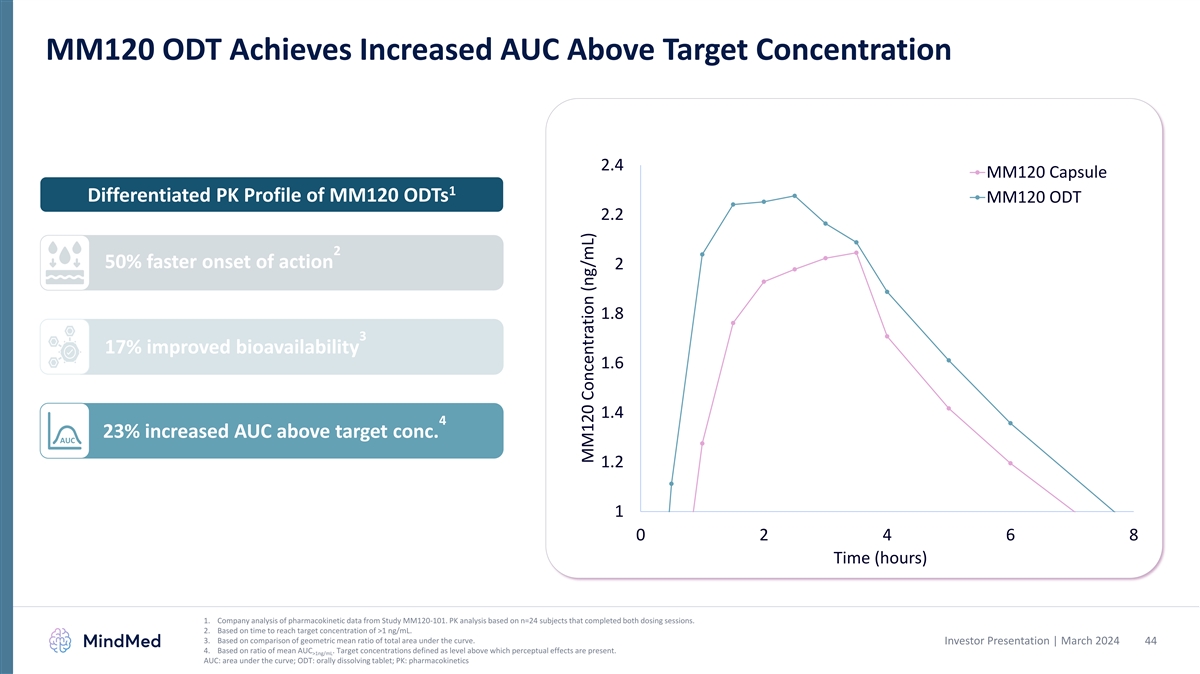
MM120 ODT Achieves Increased AUC Above Target Concentration 2.4 MM120
Capsule 1 Differentiated PK Profile of MM120 ODTs MM120 ODT 2.2 2 50% faster onset of action 2 1.8 3 17% improved bioavailability 1.6 1.4 4 23% increased AUC above target conc. AUC 1.2 1 0 2 4 6 8 Time (hours) 1. Company analysis of pharmacokinetic
data from Study MM120-101. PK analysis based on n=24 subjects that completed both dosing sessions. 2. Based on time to reach target concentration of >1 ng/mL. 3. Based on comparison of geometric mean ratio of total area under the curve. Investor
Presentation | March 2024 44 4. Based on ratio of mean AUC . Target concentrations defined as level above which perceptual effects are present. >1ng/mL AUC: area under the curve; ODT: orally dissolving tablet; PK: pharmacokinetics MM120
Concentration (ng/mL)

MM120 LSD-D-tartrate Commercial Opportunity Francois Lilienthal, MD,
MBA Chief Commercial Officer

Key Factors are in Place to Drive a Significant Commercial Opportunity
for MM120 Significant Large unmet need market Significant Established Best-in-class reimbursement Commercial profile framework Potential Large and Strong growing value infrastructure proposition Investor Presentation | March 2024 46

Psychiatric HCPs Expect Psychedelics to Radically Transform the
Treatment of 1 Anxiety and Depression % GAD Providers Agree All Providers 2 Spravato Providers 86% 84% 78% 74% 73% 62% Availability of FDA-approved psychedelic Psychedelic treatments will be a valuable I expect psychedelic treatments to radically
treatments for anxiety and depression will treatment option in the future for anxiety and transform the treatment of anxiety and change how I approach anxiety and depression depression depression 1. Psychiatrists and Psychiatry Nurse Practitioners
2. Source: MindMed Primary Market Research – Key Customer Perceptions Among Spravato® Providers and GAD Prescribers (February 2024). Total Non-Spravato® Providers (n=125), Investor Presentation | March 2024 47 Spravato®
Providers (n=50). 3. Spravato Providers: recommended, referred or prescribed Spravato® treatment and monitored or administered Spravato® treatment, personally or someone in her/his clinic or office.

Majority of Psychiatrists Are Impressed by the Clinical Activity and
Overall Profile of MM120 1,2 % of Psychiatrists Impressed by MM120 87% 87% 86% * 73% Overall Clinical Activity Onset of Activity Durability of Activity Overall Impression (Reduction in HAM-A) (CGI-S at Day 2) (HAM-A at Week 12) 1. Source: MindMed
Primary Market Research – Key Customer Perceptions Among Spravato® Providers and GAD Prescribers (February 2024). Total Non-Spravato® Providers (n=125), Spravato® Providers (n=50). Investor Presentation | March 2024 48 2.
Psychiatrists and Psychiatry Nurse Practitioners CGI-S: Clinical Global Impressions – Severity; HAM-A: Hamilton Anxiety Scale
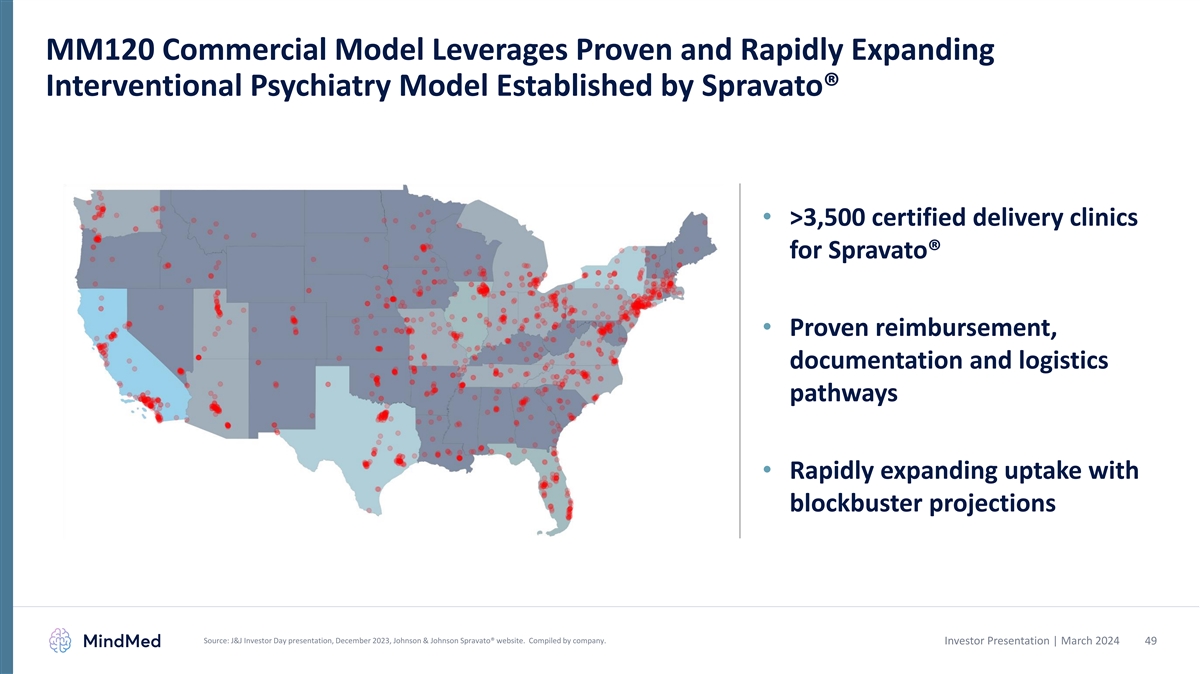
MM120 Commercial Model Leverages Proven and Rapidly Expanding
Interventional Psychiatry Model Established by Spravato® • >3,500 certified delivery clinics for Spravato® • Proven reimbursement, documentation and logistics pathways • Rapidly expanding uptake with blockbuster
projections Source: J&J Investor Day presentation, December 2023, Johnson & Johnson Spravato® website. Compiled by company. Investor Presentation | March 2024 49

Proven Pathways Already Exist for Patient Care & Reimbursement
Diagnosis + Rx Treatment Session Drug Patient Psychiatrist / Monitored by Licensed Distributed via Specialty 1 2 Prescribing HCP HCP Pharmacy Reimbursement Payer 1. HCP that is licensed to prescribe medications to patients. 2. HCP that is licensed
to practice, which may include physicians, clinical psychologists, nurse practitioners, nurses, licensed clinical social workers, licensed family and Investor Presentation | March 2024 50 marriage therapists and others.

Reimbursement Pathways Are Established for All Stakeholders, Including
for Both Drug and Session Delivery Annual Cost Spravato® Stakeholder Reimbursement/Coding Activity Local or Telehealth Medical Benefit 3 Up to $1,200 Evaluation & Prescribing 1 Prescriber E&M Code (992XX) or G Code 4 ~$25,000 –
62,000 Manufacturer via Pharmacy Benefit Drug excluding discounts and Specialty Pharmacy J or S Code + dispensing fee rebates Medical Benefit 2 Local HCP to E&M Code 5 Up to $17,000 Session Delivery monitor treatment Reimbursed on hourly basis
for prolonged clinical session staff service 1. HCP that is licensed to prescribe medications to patients. 2. HCP that is licensed to practice, which may include physicians, clinical psychologists, nurse practitioners, nurses, licensed clinical
social workers, licensed family and marriage therapists and others. 3. Based on up to 8 evaluation visits at assumed cost of $150 per visit. CPT codes and reimbursement for MM120 have not been established. Investor Presentation | March 2024 51 4.
Manufacturer price based on 2 or 3 canisters per session times 34 to 56 sessions per year. CPT codes and reimbursement for MM120 have not been established. 5. Based on up to 112 hours of required monitoring that is reimbursed at approximately $150
per hour (Source: MindMed primary research). CPT codes and reimbursement for MM120 have not been established.

MM120 Could Offer Significant Advantages over Spravato® in both
Clinical and Session Delivery Profiles 1 2 MM120 Durability of activity 1 week or less 3 months + Time spent receiving Up to 112 hours ~ 8 to 32 hours treatment / year Number of treatment Up to 56 1 to 4 sessions / year Up to 56 submissions 1-4
submissions to Documentation to insurance & REMS insurance & REMS burden REMS-required Favorable tolerability Physiological side CV monitoring in Phase 2b study effect monitoring 1. Based on Spravato Prescribing Information and information
contained under the Spravato REMS at https://www.spravatorems.com. 2. If MM120 becomes FDA approved and marketed. Durability, tolerability and associated treatment interval assumptions based on demonstration of statistically significant reductions
in Investor Presentation | March 2024 52 HAM-A at week 12 in Phase 2b clinical trial MMED008. Assumes average 8 hour monitoring per dosing session of MM120.
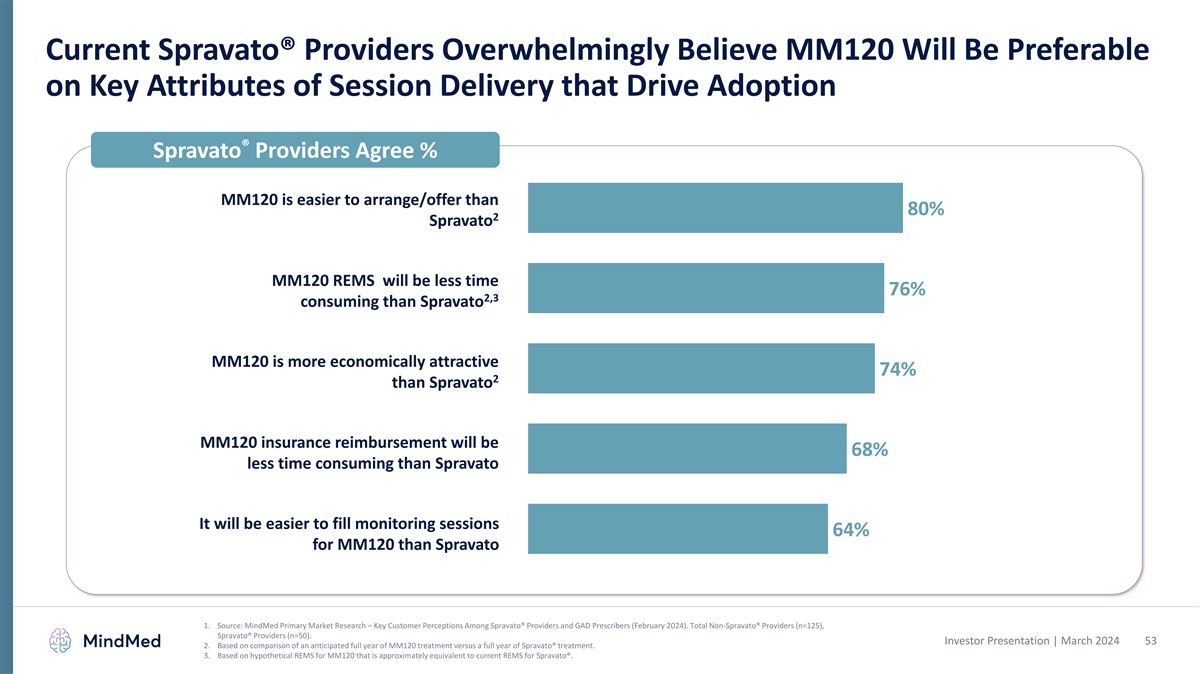
Current Spravato® Providers Overwhelmingly Believe MM120 Will Be
Preferable on Key Attributes of Session Delivery that Drive Adoption ® Spravato Providers Agree % MM120 is easier to arrange/offer than 80% 2 Spravato MM120 REMS will be less time 76% 2,3 consuming than Spravato MM120 is more economically
attractive 74% 2 than Spravato MM120 insurance reimbursement will be 68% less time consuming than Spravato It will be easier to fill monitoring sessions 64% for MM120 than Spravato 1. Source: MindMed Primary Market Research – Key Customer
Perceptions Among Spravato® Providers and GAD Prescribers (February 2024). Total Non-Spravato® Providers (n=125), Spravato® Providers (n=50). Investor Presentation | March 2024 53 2. Based on comparison of an anticipated full year of
MM120 treatment versus a full year of Spravato® treatment. 3. Based on hypothetical REMS for MM120 that is approximately equivalent to current REMS for Spravato®.

® Vast Majority of Current Spravato Providers Indicate They Are
Likely To Refer, 1 Prescribe and Administer MM120 92% 84% Current Spravato® Providers Likely to Refer Current Spravato® Providers Likely to Prescribe 2 2 Patient for MM120 and Administer MM120 1. Source: MindMed Primary Market Research
– Key Customer Perceptions Among Spravato® Providers and GAD Prescribers (February 2024). Total Non-Spravato® Providers (n=125), Spravato® Providers (n=50). Investor Presentation | March 2024 54 2. If MM120 becomes FDA approved
and marketed.

Payer Perspectives on the Potential Value of MM120 Predictability of
response early Tolerability and compliance Durable reduction of anxiety in treatment course enables profile supports low-waste and comorbidities reduces efficient use of resources budget impact healthcare utilization and cost burden 2 1 3
Predictability of response early in treatment course Behavioral health issues drive costs….as you think about the development of the behavioral health enables efficient use of space, all employers are interested in it. I can't say that
enough.…we have observation coverage, resources psychological evaluation coverage, E&M codes…and precedents include Spravato, sleep “ studies…there is an unmet need, it's going to get covered, if it's FDA approved…
1 – BCBS Regional Payer Source: Company conducted qualitative research with US payers; MindMed 2023 Analyst Day. Investor Presentation | March 2024 55

GAD Has a Major Impact on Employers by Driving Employee Disengagement
and Work Productivity Loss Diagnosed Severe 1 Group Control 2 GAD • Potential impact of MM120 extends beyond direct health benefits and drives broad value Absenteeism 6.0% 21.0% proposition • Employers play important role in Presenteeism
14.1% 47.5% driving reimbursement as a key stakeholder to payers Work 16.4% 53.0% Productivity Loss Source: NHWS 2022 annual survey 1. General population without GAD symptoms measured by GAD-7 Investor Presentation | March 2024 56 2 Severe symptoms
as measured by GAD-7

Advancing a Focused Strategy to Deliver on the Commercial Opportunity
for MM120 Educate Stakeholders Maximize Access and about GAD & MM120 Reimbursement MM120 Value Proposition Integrate MM120 Session Delivery into Current Infrastructure Investor Presentation | March 2024 57
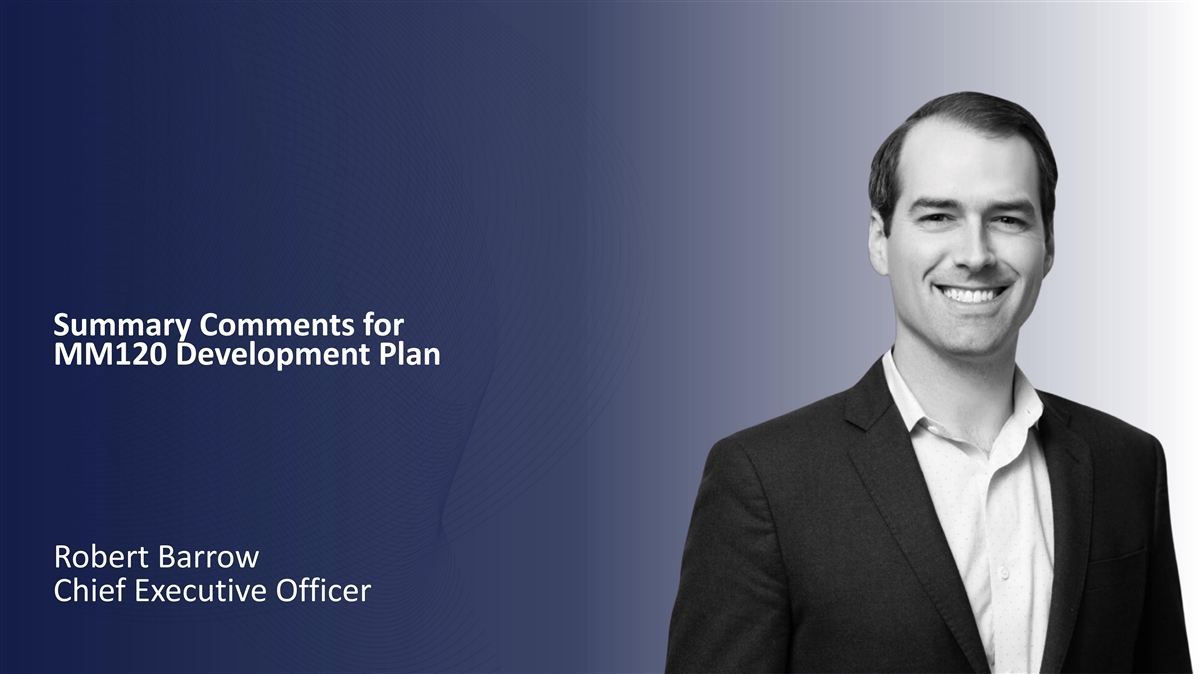
Summary Comments for MM120 Development Plan Robert Barrow Chief
Executive Officer

Multiple Studies Support Phase 3 Development of MM120 1 •
Achieved goals of Phase 2 development o Characterized dose-response to inform dose selection in GAD o Large, statistically significant and clinically meaningful effect in GAD o Rapid and durable therapeutic benefits on validated endpoint o
Standalone drug effect in absence of psychotherapeutic intervention • Multiple double-blind, placebo-controlled studies supporting activity of MM120 o Phase 2b randomized, placebo-controlled dose optimization trial in GAD (Study MMED008) o One
prior modern, randomized, placebo-controlled IIT of lysergide in anxiety disorders o Over twenty legacy studies of lysergide in anxiety and other neurotic disorders • Phase 2b data supports dose selection and advancement into Phase 3
development 1. Source: Study MMED008 internal study documents and calculations. Investor Presentation | March 2024 59

MM120 Development Pathway 1 • Two Phase 3 pivotal clinical trials
in planning o 12-week randomized, placebo-controlled primary efficacy study design o Open-label extension to establish retreatment parameters o Expect to initiate Phase 3 development in the second half of 2024 • Key design elements expected to
be consistent between Phase 2b and Phase 3 studies o Hamilton Anxiety Scale (HAM-A) at week 4 expected primary endpoint o Limited changes to key inclusion/exclusion criteria o No planned change in dosing session monitoring protocol 1. Phase 3 and
subsequent clinical study design subject to regulatory discussion and review, including at potential End of Phase 2 meeting. Investor Presentation | March 2024 60

Next Steps and Anticipated Milestones for MM120 and Pipeline Programs
Q1 2024 Q2 2024 Q3 2024 Q4 2024 MM120 GAD MM120 GAD Phase 2b / 12-wk Topline Full data presentation at scientific meeting MM120 GAD Zydis ODT PK Bridging Data MM120 GAD MM120 GAD Phase 3 initiation End-of-Phase-2 meeting w/FDA MM120 Evaluate
additional clinical indication(s) for MM120 MM402/R-MDMA Phase 1 IIT (UHB-sponsored) Topline Investor Presentation | March 2024 61
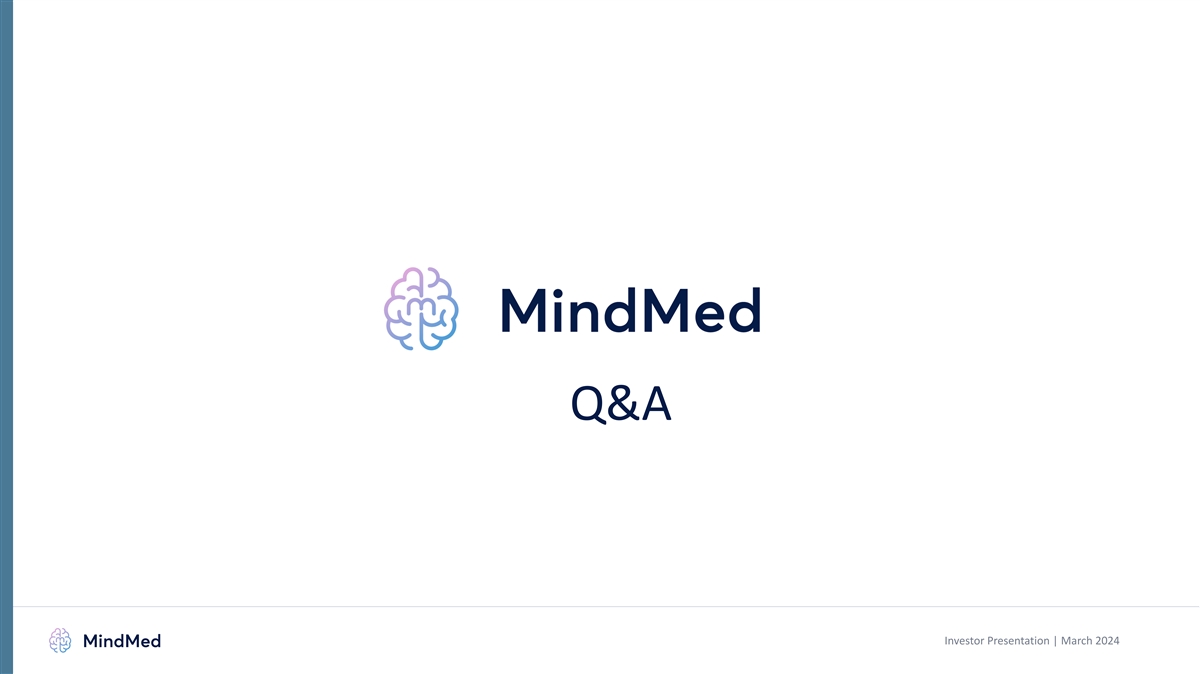
Q&A Investor Presentation | March 2024

Appendix

1,3 65% HAM-A Response Rate (HAM-A) Achieved at Week 12 2 HAM-A
Response Rate Over Time 90 78 78 78 78 80 75 70 68 70 65 63 58 60 56 54 53 51 51 50 49 50 47 44 44 38 40 33 31 31 31 30 20 10 0 Week 1 Week 2 Week 4 Week 8 Week 12 p-values not calculated Placebo 25 µg 50 µg 100 µg 200 µg 1.
Source: Study MMED008 internal study documents and calculations. Full analysis set population. 2. Response is defined as a 50% or greater improvement on HAM-A score. Investor Presentation | March 2024 3. Based on 100 µg dose group. μg:
microgram; HAM-A: Hamilton Anxiety Rating Scale. % Responders

1,3 48% Remission Rate (HAM-A) Achieved through Week 12 2 HAM-A
Remission Rate Over Time 60 50 50 48 45 45 45 43 40 38 35 33 33 33 33 33 33 33 31 30 28 28 26 25 21 21 21 20 18 15 10 0 Week 1 Week 2 Week 4 Week 8 Week 12 p-values not calculated Placebo 25 µg 50 µg 100 µg 200 µg 1. Source:
Study MMED008 internal study documents and calculations. Full analysis set population. 2. Remission is defined as a HAM-A score of ≤ 7. Investor Presentation | March 2024 3. Based on 100 µg dose group. μg: microgram; HAM-A: Hamilton
Anxiety Rating Scale. % Remitters

Statistically Significant Improvement in Clinical Global Impressions
– Severity (CGI-S) 1,2 Score Achieved by Day 2 and Sustained through Week 12 CGI-S Scores Over Time 6 – Severely Ill 5 – Markedly Ill 4 – Moderately Ill * *** 3 – Mildly Ill * *** ** *** * * *** * * * *** *** * * ** 2
– Borderline Ill 1 – Normal, not Baseline Day 2 Week 1 Week 2 Week 4 Week 8 Week 12 ill at all *p<0.05 Placebo 25 µg 50 µg 100 µg 200 µg **p≤0.01 ***p≤0.001 ****p≤0.0001 1. Source: Study MMED008
internal study documents and calculations. Full analysis set population. 2. Based on 100 µg dose group. Investor Presentation | March 2024 μg: microgram; CGI-S: Clinical Global Impressions – Severity
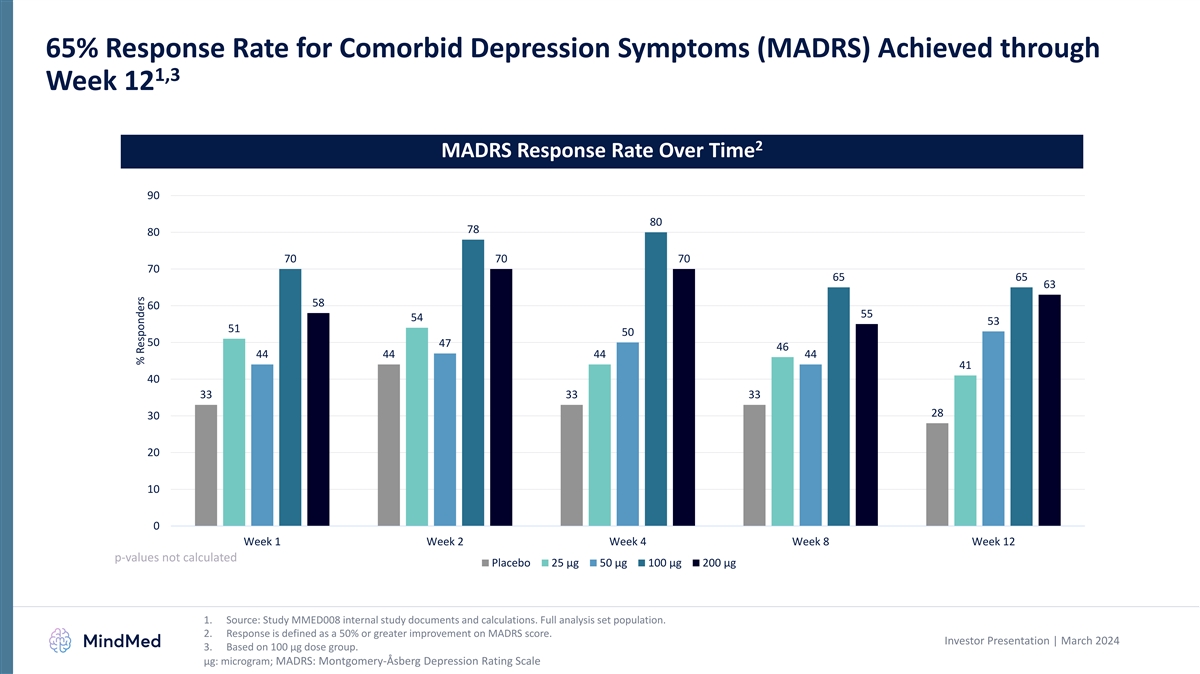
65% Response Rate for Comorbid Depression Symptoms (MADRS) Achieved
through 1,3 Week 12 2 MADRS Response Rate Over Time 90 80 78 80 70 70 70 70 65 65 63 58 60 55 54 53 51 50 50 47 46 44 44 44 44 41 40 33 33 33 28 30 20 10 0 Week 1 Week 2 Week 4 Week 8 Week 12 p-values not calculated Placebo 25 µg 50 µg 100
µg 200 µg 1. Source: Study MMED008 internal study documents and calculations. Full analysis set population. 2. Response is defined as a 50% or greater improvement on MADRS score. Investor Presentation | March 2024 3. Based on 100 µg
dose group. μg: microgram; MADRS: Montgomery-Åsberg Depression Rating Scale % Responders
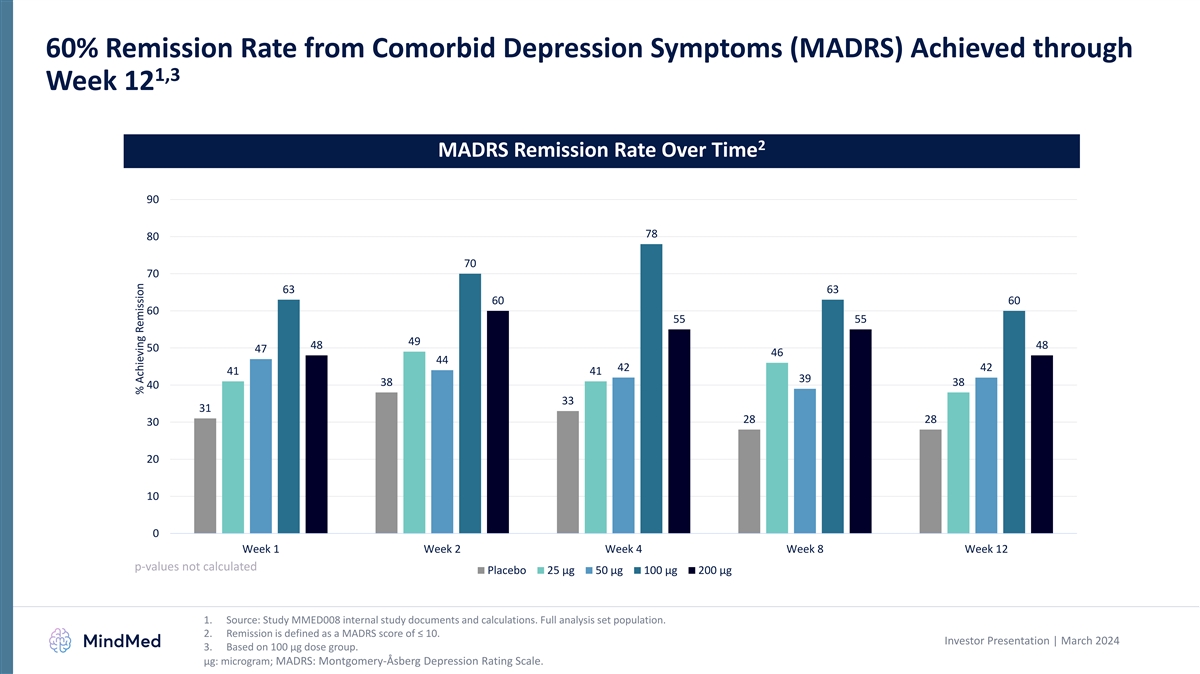
60% Remission Rate from Comorbid Depression Symptoms (MADRS) Achieved
through 1,3 Week 12 2 MADRS Remission Rate Over Time 90 78 80 70 70 63 63 60 60 60 55 55 49 48 48 50 47 46 44 42 42 41 41 39 38 38 40 33 31 28 28 30 20 10 0 Week 1 Week 2 Week 4 Week 8 Week 12 p-values not calculated Placebo 25 µg 50 µg
100 µg 200 µg 1. Source: Study MMED008 internal study documents and calculations. Full analysis set population. 2. Remission is defined as a MADRS score of ≤ 10. Investor Presentation | March 2024 3. Based on 100 µg dose group.
μg: microgram; MADRS: Montgomery-Åsberg Depression Rating Scale. % Achieving Remission
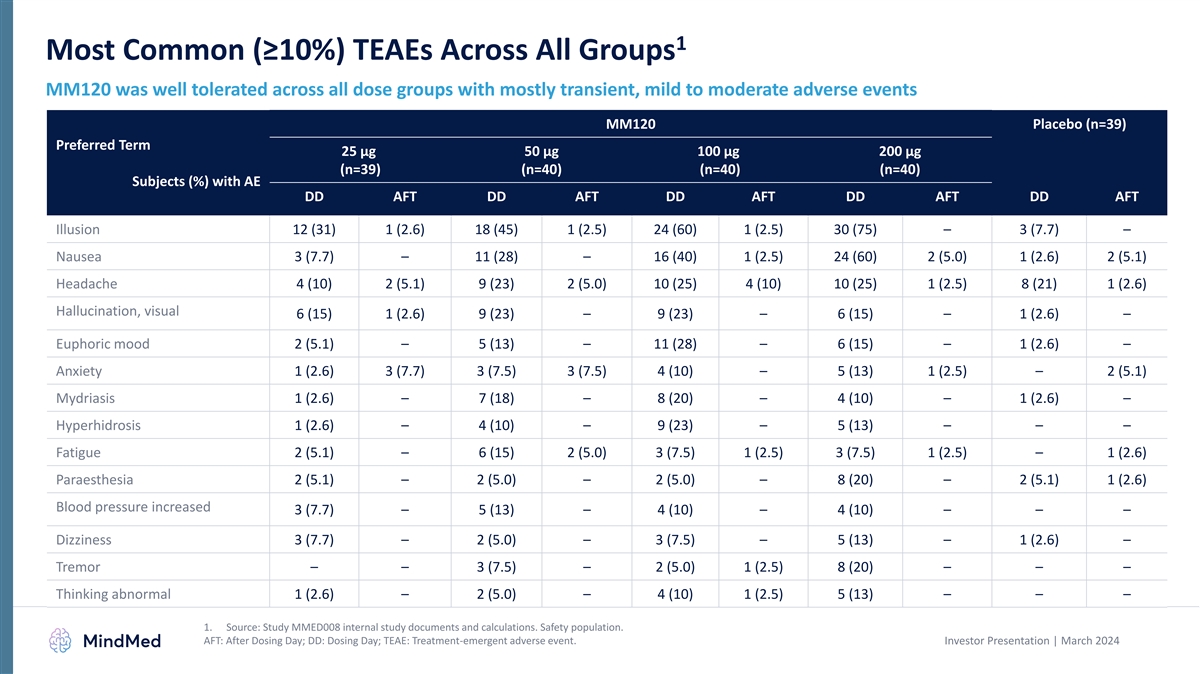
1 Most Common (≥10%) TEAEs Across All Groups MM120 was well
tolerated across all dose groups with mostly transient, mild to moderate adverse events MM120 Placebo (n=39) Preferred Term 25 µg 50 µg 100 µg 200 µg (n=39) (n=40) (n=40) (n=40) Subjects (%) with AE DD AFT DD AFT DD AFT DD AFT DD
AFT Illusion 12 (31) 1 (2.6) 18 (45) 1 (2.5) 24 (60) 1 (2.5) 30 (75) – 3 (7.7) – Nausea 3 (7.7) – 11 (28) – 16 (40) 1 (2.5) 24 (60) 2 (5.0) 1 (2.6) 2 (5.1) Headache 4 (10) 2 (5.1) 9 (23) 2 (5.0) 10 (25) 4 (10) 10 (25) 1 (2.5)
8 (21) 1 (2.6) Hallucination, visual 6 (15) 1 (2.6) 9 (23) – 9 (23) – 6 (15) – 1 (2.6) – Euphoric mood 2 (5.1) – 5 (13) – 11 (28) – 6 (15) – 1 (2.6) – Anxiety 1 (2.6) 3 (7.7) 3 (7.5) 3 (7.5) 4
(10) – 5 (13) 1 (2.5) – 2 (5.1) Mydriasis 1 (2.6) – 7 (18) – 8 (20) – 4 (10) – 1 (2.6) – Hyperhidrosis 1 (2.6) – 4 (10) – 9 (23) – 5 (13) – – – Fatigue 2 (5.1) – 6
(15) 2 (5.0) 3 (7.5) 1 (2.5) 3 (7.5) 1 (2.5) – 1 (2.6) Paraesthesia 2 (5.1) – 2 (5.0) – 2 (5.0) – 8 (20) – 2 (5.1) 1 (2.6) Blood pressure increased 3 (7.7) – 5 (13) – 4 (10) – 4 (10) – –
– Dizziness 3 (7.7) – 2 (5.0) – 3 (7.5) – 5 (13) – 1 (2.6) – Tremor – – 3 (7.5) – 2 (5.0) 1 (2.5) 8 (20) – – – Thinking abnormal 1 (2.6) – 2 (5.0) – 4 (10) 1 (2.5) 5
(13) – – – 1. Source: Study MMED008 internal study documents and calculations. Safety population. AFT: After Dosing Day; DD: Dosing Day; TEAE: Treatment-emergent adverse event. Investor Presentation | March 2024

1 Most Common (≥10%) TEAEs Across All Groups (cont) MM120 was
well tolerated across all dose groups with mostly transient, mild to moderate adverse events MM120 Placebo (n=39) Preferred Term 25 µg 50 µg 100 µg 200 µg (n=39) (n=40) (n=40) (n=40) Subjects (%) with AE DD AFT DD AFT DD AFT DD
AFT DD AFT Balance disorder – – 4 (10) – 3 (7.5) – 2 (5.0) – 1 (2.6) – Pseudohallucination – – 3 (7.5) – 3 (7.5) – 4 (10) – – – Vomiting – – 2 (5.0) – 2
(5.0) – 5 (13) – – – Disturbance in attention 1 (2.6) – 5 (13) 1 (2.5) – 1 (2.5) – – – – Feeling abnormal 1 (2.6) – 2 (5.0) – – – – 4 (10) 1 (2.6) 1 (2.6)
COVID-19 – 1 (2.6) – 2 (5.0) – 1 (2.5) – 4 (10) – – 1. Source: Study MMED008 internal study documents and calculations. Safety population. AFT: After Dosing Day; DD: Dosing Day; TEAE: Treatment-emergent adverse
event. Investor Presentation | March 2024
v3.24.0.1
| X |
- DefinitionBoolean flag that is true when the XBRL content amends previously-filed or accepted submission.
| Name: |
dei_AmendmentFlag |
| Namespace Prefix: |
dei_ |
| Data Type: |
xbrli:booleanItemType |
| Balance Type: |
na |
| Period Type: |
duration |
|
| X |
- DefinitionFor the EDGAR submission types of Form 8-K: the date of the report, the date of the earliest event reported; for the EDGAR submission types of Form N-1A: the filing date; for all other submission types: the end of the reporting or transition period. The format of the date is YYYY-MM-DD.
| Name: |
dei_DocumentPeriodEndDate |
| Namespace Prefix: |
dei_ |
| Data Type: |
xbrli:dateItemType |
| Balance Type: |
na |
| Period Type: |
duration |
|
| X |
- DefinitionThe type of document being provided (such as 10-K, 10-Q, 485BPOS, etc). The document type is limited to the same value as the supporting SEC submission type, or the word 'Other'.
| Name: |
dei_DocumentType |
| Namespace Prefix: |
dei_ |
| Data Type: |
dei:submissionTypeItemType |
| Balance Type: |
na |
| Period Type: |
duration |
|
| X |
- DefinitionAddress Line 1 such as Attn, Building Name, Street Name
| Name: |
dei_EntityAddressAddressLine1 |
| Namespace Prefix: |
dei_ |
| Data Type: |
xbrli:normalizedStringItemType |
| Balance Type: |
na |
| Period Type: |
duration |
|
| X |
- DefinitionAddress Line 2 such as Street or Suite number
| Name: |
dei_EntityAddressAddressLine2 |
| Namespace Prefix: |
dei_ |
| Data Type: |
xbrli:normalizedStringItemType |
| Balance Type: |
na |
| Period Type: |
duration |
|
| X |
- Definition
+ References
+ Details
| Name: |
dei_EntityAddressCityOrTown |
| Namespace Prefix: |
dei_ |
| Data Type: |
xbrli:normalizedStringItemType |
| Balance Type: |
na |
| Period Type: |
duration |
|
| X |
- DefinitionCode for the postal or zip code
| Name: |
dei_EntityAddressPostalZipCode |
| Namespace Prefix: |
dei_ |
| Data Type: |
xbrli:normalizedStringItemType |
| Balance Type: |
na |
| Period Type: |
duration |
|
| X |
- DefinitionName of the state or province.
| Name: |
dei_EntityAddressStateOrProvince |
| Namespace Prefix: |
dei_ |
| Data Type: |
dei:stateOrProvinceItemType |
| Balance Type: |
na |
| Period Type: |
duration |
|
| X |
- DefinitionA unique 10-digit SEC-issued value to identify entities that have filed disclosures with the SEC. It is commonly abbreviated as CIK. Reference 1: http://www.xbrl.org/2003/role/presentationRef
-Publisher SEC
-Name Exchange Act
-Number 240
-Section 12
-Subsection b-2
| Name: |
dei_EntityCentralIndexKey |
| Namespace Prefix: |
dei_ |
| Data Type: |
dei:centralIndexKeyItemType |
| Balance Type: |
na |
| Period Type: |
duration |
|
| X |
- DefinitionIndicate if registrant meets the emerging growth company criteria. Reference 1: http://www.xbrl.org/2003/role/presentationRef
-Publisher SEC
-Name Exchange Act
-Number 240
-Section 12
-Subsection b-2
| Name: |
dei_EntityEmergingGrowthCompany |
| Namespace Prefix: |
dei_ |
| Data Type: |
xbrli:booleanItemType |
| Balance Type: |
na |
| Period Type: |
duration |
|
| X |
- DefinitionCommission file number. The field allows up to 17 characters. The prefix may contain 1-3 digits, the sequence number may contain 1-8 digits, the optional suffix may contain 1-4 characters, and the fields are separated with a hyphen.
| Name: |
dei_EntityFileNumber |
| Namespace Prefix: |
dei_ |
| Data Type: |
dei:fileNumberItemType |
| Balance Type: |
na |
| Period Type: |
duration |
|
| X |
- DefinitionTwo-character EDGAR code representing the state or country of incorporation.
| Name: |
dei_EntityIncorporationStateCountryCode |
| Namespace Prefix: |
dei_ |
| Data Type: |
dei:edgarStateCountryItemType |
| Balance Type: |
na |
| Period Type: |
duration |
|
| X |
- DefinitionThe exact name of the entity filing the report as specified in its charter, which is required by forms filed with the SEC. Reference 1: http://www.xbrl.org/2003/role/presentationRef
-Publisher SEC
-Name Exchange Act
-Number 240
-Section 12
-Subsection b-2
| Name: |
dei_EntityRegistrantName |
| Namespace Prefix: |
dei_ |
| Data Type: |
xbrli:normalizedStringItemType |
| Balance Type: |
na |
| Period Type: |
duration |
|
| X |
- DefinitionThe Tax Identification Number (TIN), also known as an Employer Identification Number (EIN), is a unique 9-digit value assigned by the IRS. Reference 1: http://www.xbrl.org/2003/role/presentationRef
-Publisher SEC
-Name Exchange Act
-Number 240
-Section 12
-Subsection b-2
| Name: |
dei_EntityTaxIdentificationNumber |
| Namespace Prefix: |
dei_ |
| Data Type: |
dei:employerIdItemType |
| Balance Type: |
na |
| Period Type: |
duration |
|
| X |
- DefinitionLocal phone number for entity.
| Name: |
dei_LocalPhoneNumber |
| Namespace Prefix: |
dei_ |
| Data Type: |
xbrli:normalizedStringItemType |
| Balance Type: |
na |
| Period Type: |
duration |
|
| X |
- DefinitionBoolean flag that is true when the Form 8-K filing is intended to satisfy the filing obligation of the registrant as pre-commencement communications pursuant to Rule 13e-4(c) under the Exchange Act. Reference 1: http://www.xbrl.org/2003/role/presentationRef
-Publisher SEC
-Name Exchange Act
-Number 240
-Section 13e
-Subsection 4c
| Name: |
dei_PreCommencementIssuerTenderOffer |
| Namespace Prefix: |
dei_ |
| Data Type: |
xbrli:booleanItemType |
| Balance Type: |
na |
| Period Type: |
duration |
|
| X |
- DefinitionBoolean flag that is true when the Form 8-K filing is intended to satisfy the filing obligation of the registrant as pre-commencement communications pursuant to Rule 14d-2(b) under the Exchange Act. Reference 1: http://www.xbrl.org/2003/role/presentationRef
-Publisher SEC
-Name Exchange Act
-Number 240
-Section 14d
-Subsection 2b
| Name: |
dei_PreCommencementTenderOffer |
| Namespace Prefix: |
dei_ |
| Data Type: |
xbrli:booleanItemType |
| Balance Type: |
na |
| Period Type: |
duration |
|
| X |
- DefinitionTitle of a 12(b) registered security. Reference 1: http://www.xbrl.org/2003/role/presentationRef
-Publisher SEC
-Name Exchange Act
-Number 240
-Section 12
-Subsection b
| Name: |
dei_Security12bTitle |
| Namespace Prefix: |
dei_ |
| Data Type: |
dei:securityTitleItemType |
| Balance Type: |
na |
| Period Type: |
duration |
|
| X |
- DefinitionName of the Exchange on which a security is registered. Reference 1: http://www.xbrl.org/2003/role/presentationRef
-Publisher SEC
-Name Exchange Act
-Number 240
-Section 12
-Subsection d1-1
| Name: |
dei_SecurityExchangeName |
| Namespace Prefix: |
dei_ |
| Data Type: |
dei:edgarExchangeCodeItemType |
| Balance Type: |
na |
| Period Type: |
duration |
|
| X |
- DefinitionBoolean flag that is true when the Form 8-K filing is intended to satisfy the filing obligation of the registrant as soliciting material pursuant to Rule 14a-12 under the Exchange Act. Reference 1: http://www.xbrl.org/2003/role/presentationRef
-Publisher SEC
-Name Exchange Act
-Section 14a
-Number 240
-Subsection 12
| Name: |
dei_SolicitingMaterial |
| Namespace Prefix: |
dei_ |
| Data Type: |
xbrli:booleanItemType |
| Balance Type: |
na |
| Period Type: |
duration |
|
| X |
- DefinitionTrading symbol of an instrument as listed on an exchange.
| Name: |
dei_TradingSymbol |
| Namespace Prefix: |
dei_ |
| Data Type: |
dei:tradingSymbolItemType |
| Balance Type: |
na |
| Period Type: |
duration |
|
| X |
- DefinitionBoolean flag that is true when the Form 8-K filing is intended to satisfy the filing obligation of the registrant as written communications pursuant to Rule 425 under the Securities Act. Reference 1: http://www.xbrl.org/2003/role/presentationRef
-Publisher SEC
-Name Securities Act
-Number 230
-Section 425
| Name: |
dei_WrittenCommunications |
| Namespace Prefix: |
dei_ |
| Data Type: |
xbrli:booleanItemType |
| Balance Type: |
na |
| Period Type: |
duration |
|
Mind Medicine MindMed (NASDAQ:MNMD)
Historical Stock Chart
From Mar 2024 to Apr 2024
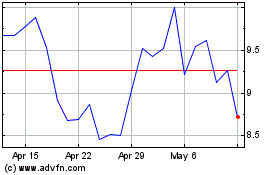
Mind Medicine MindMed (NASDAQ:MNMD)
Historical Stock Chart
From Apr 2023 to Apr 2024
